Sh2-132 (LBN 473) “Lion Nebula” in SHO
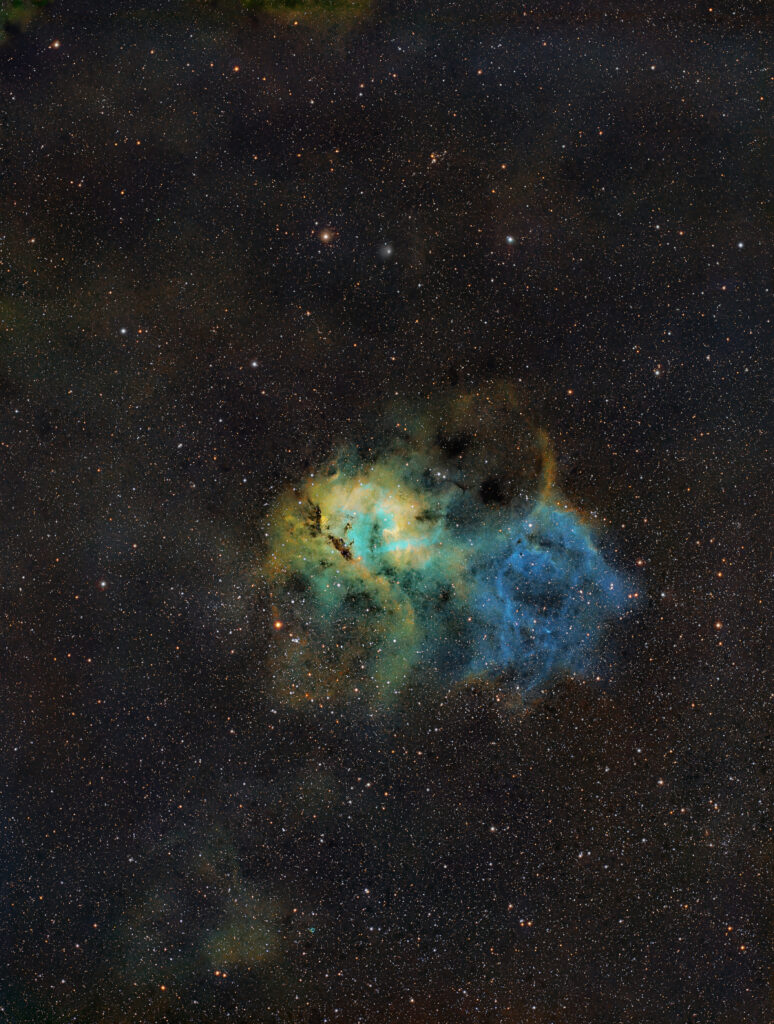
Astrobin:
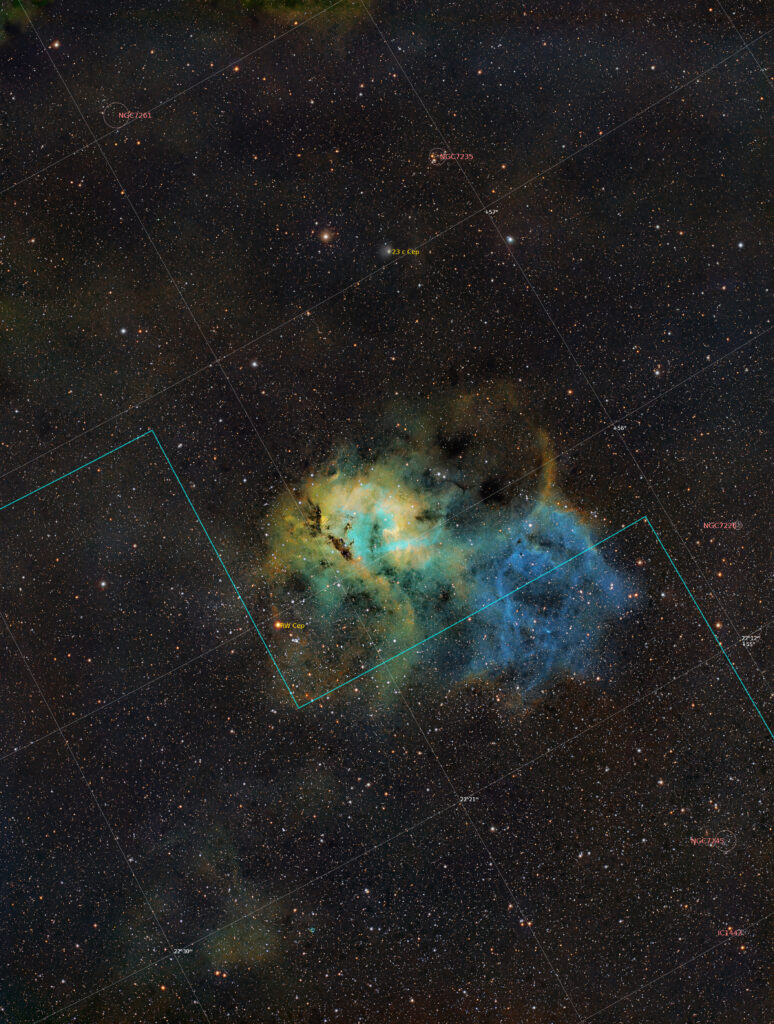
Starless
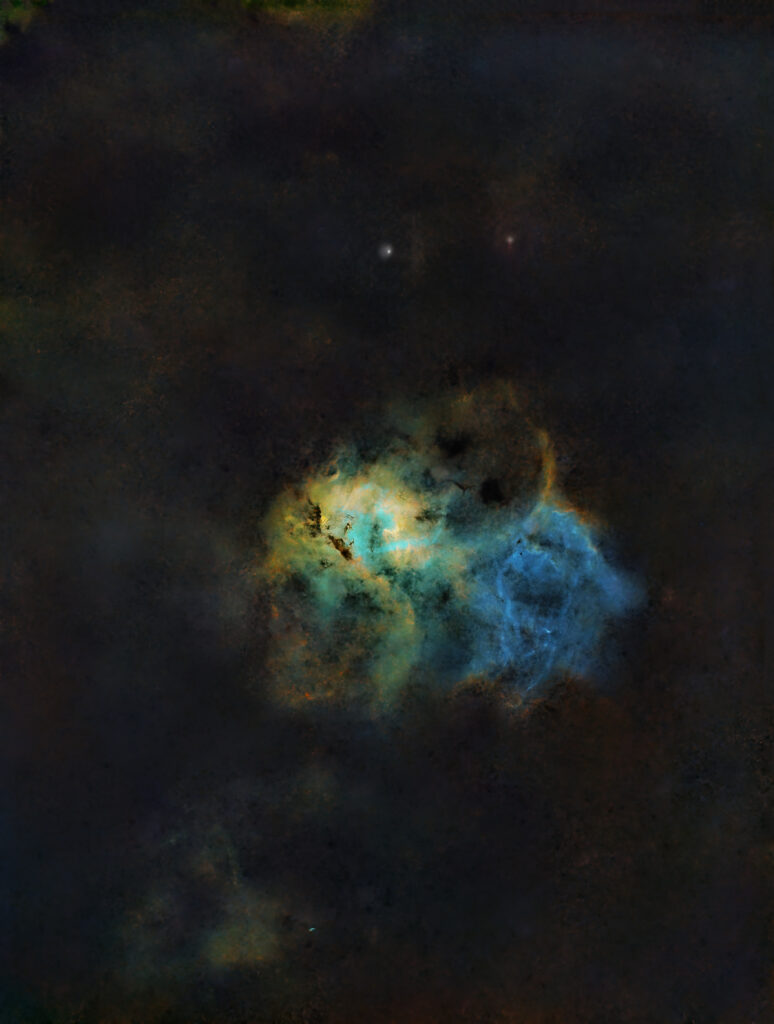
Crop
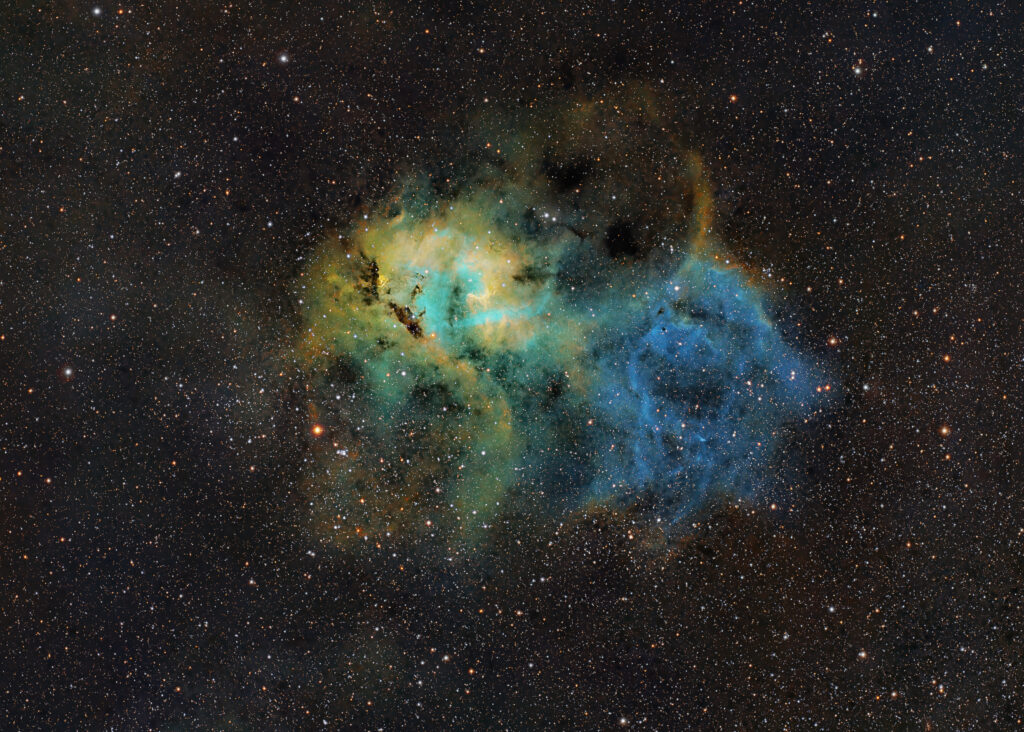
Crop and Starless
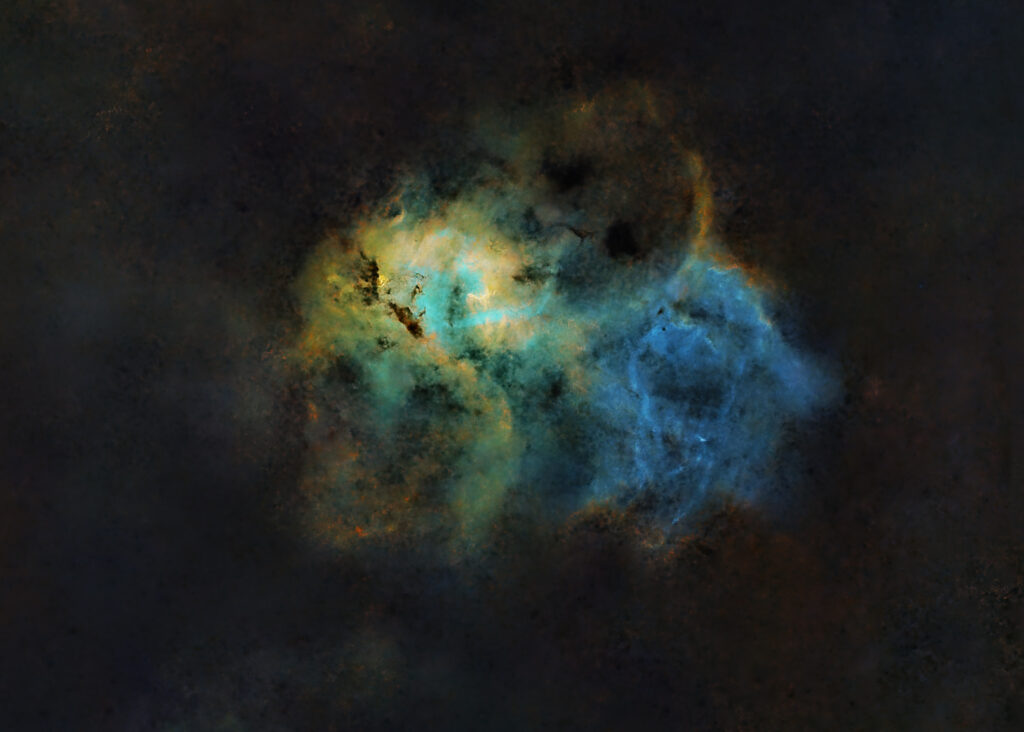

Astrobin:

Starless

Crop

Crop and Starless

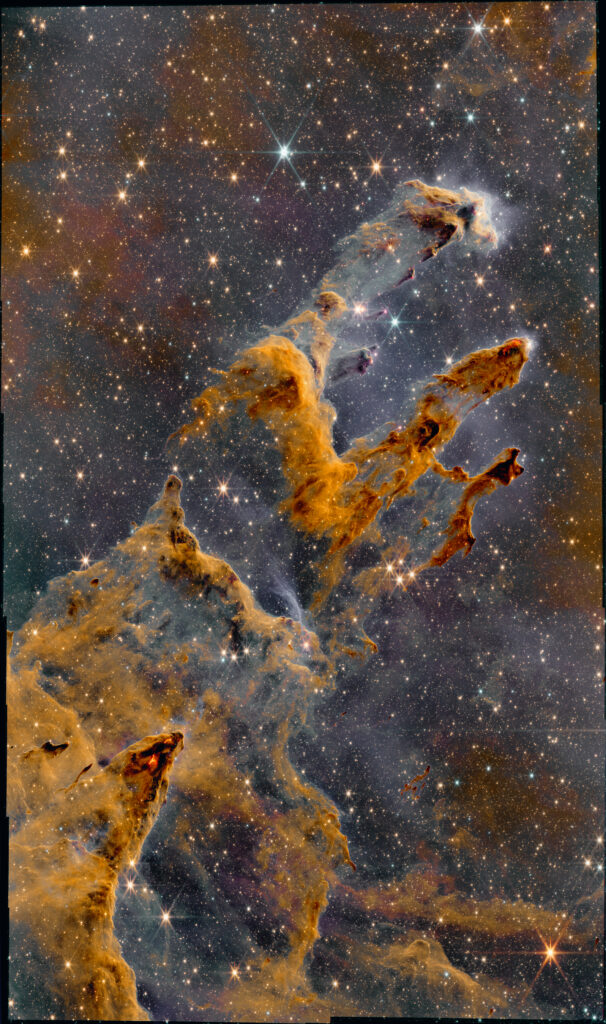
According to Greg T. Bacon of the Space Telescope Science Institute of Baltimora [ https://webbtelescope.org/contents/media/videos/1097-Video 20/07/2023 ] stars cluster belonging to M16 consist in a group of around 8.000 formed roughly 5.5 milion years ago, immersing within a cloud of gas and dust illuminated by the central cluster of bright youngest new formed stars.
The Pillars of Creation sit inside this wide region of gas and dust being pushed from the inside out by powerful stellar winds.
The winds blow back the edges of the cloud, creating dense regions that then collapse under their own gravity to form stars.
The characteristic fingers of the Pillars are some of the densest gas in this region, hanging on against the strong winds.
In the visible-light view they are entirely in shadow: such visible-light gazing shows the illumination of the inside of the gas and dust.
James Webb scope focused about the iconic Pillars of Creation, immense towers carved out of the cold dust by high-energy electromagnetic radiation emitted by the hot stars.
Webb NIRCAM eye investigating the pillars of gas and dust which block visible light, reveals what is under nebulosity concealing, with stars forming within them shining of infrared light through the dust-block, revealing stars forming within the pillars as well as stars far beyond; X-ray light also shines through the pillars, revealing extremely hot stars, most of which lie beyond the nebula.
NIRCAM Near-Infrared shows cooler towers and field of dust with many young stars.
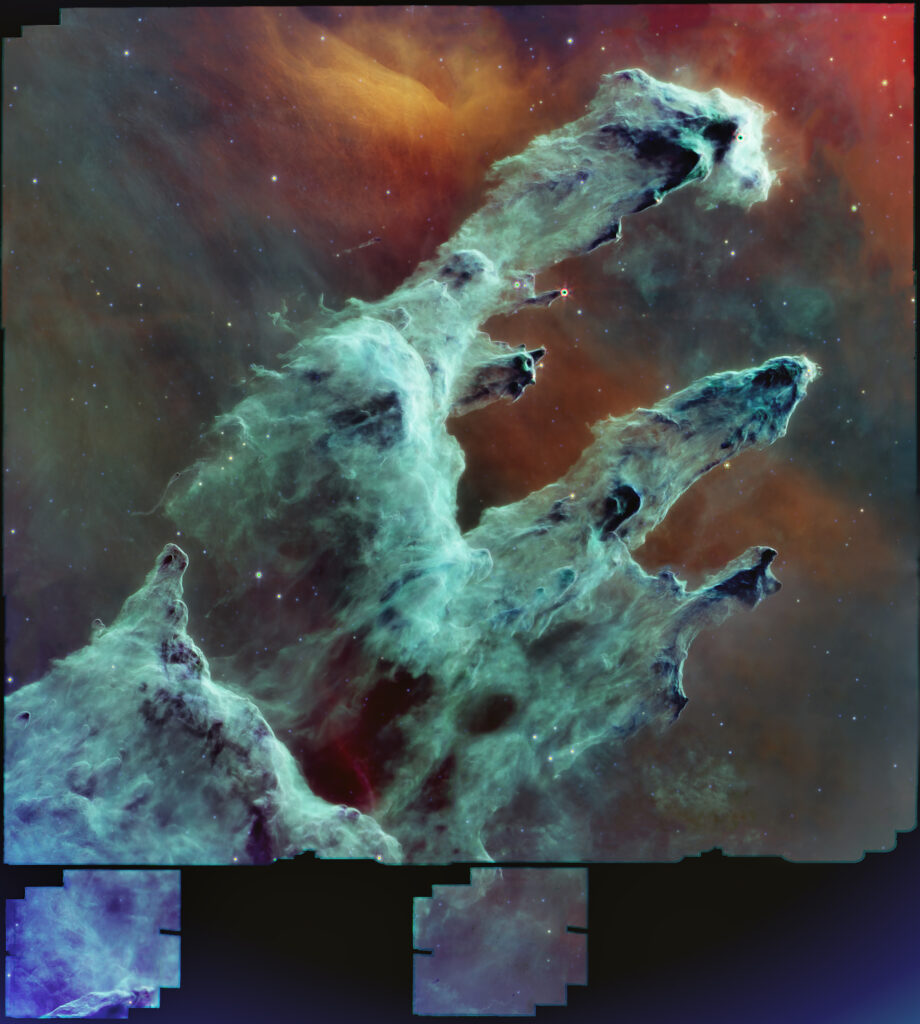
MIRI records pointing at the bottom left shows the thickest regions of gas and dust, which appear light blue and dark gray-blue: there are many layers of semi-opaque gas and dust overlaying one another.
The first pillar points to the top right of the image.
There is one prominent red star, with tiny spikes at its tip.
Lower on this pillar, which forms a diagonal from bottom left to top right, there are several darker areas of dust that jut out, many with bright red stars, which appear as small red dots.
Below the top pillar are two slightly smaller, both ending in dark gray-blue regions: the second pillar has a dark arch that looks like an upside-down L halfway down, while the third pillar is set off in dark blue and gray shades.
At the bottom left is another overlapping area of gas and dust that forms a peak, but is also colored in various shades of gray and light blue.
Background of this scene is washed in shades of deep red and light red. Toward the top center, a V shape appears above the top-most pillar. At its lowest point, it is brilliant red. There are only several dozen tiny bright white and blue stars. Larger stars appear redder and are embedded in the pillars.
According to Claire Blome and Christine Pulliam – Space Telescope Science Institue of Baltimore – Mid-infrared light set such a somber, chilling mood in Webb’s Mid-Infrared Instrument (MIRI) because interstellar dust cloaks the scene, and while mid-infrared light specializes in detailing where dust is, the stars aren’t bright enough at these wavelengths to appear. Instead, these looming, leaden-hued pillars of gas and dust gleam at their edges, hinting at the activity within.
*** Processing method ***
.fits level 3 calibration raw data I downloaded from mast.stsci.edu portal.
NIRCAM set is made of 6 .fit image recording pillars by filter f090w, f187n, f200w, f335m, f444w and f444w+f470n.
After linear fit to f200w band, according to NIRCAM filters guideline, I considered f444w and f470n as the highest signal available, to be processed as red in colour mapping.
Blue mapping I assigned to the lowest band records available, thus melting f090w and f187n in PixelMath; the same for f200w and f335m melting for the middle signal green color in rgb layout.
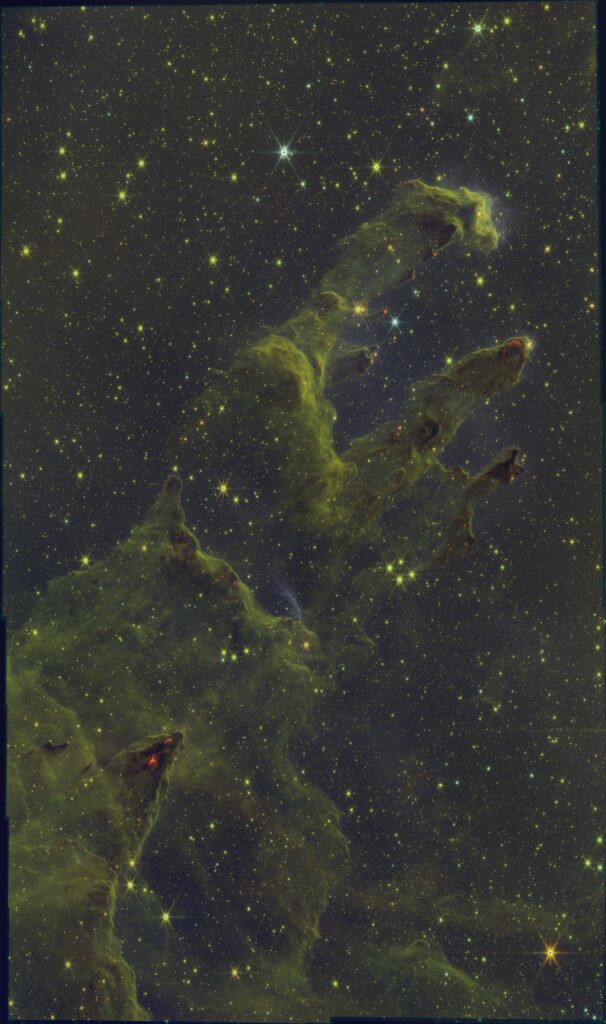
RGB channel combination produced a greenish dominated master, processed in PixInSight by very soft bg removal, denoising workflow, starXterminator work for starless and stars separate file.
I thus focused on starless master for color manipulation by color mask and curves transformation, dark area enhancing, denoising and final blurxTerminating for details revelation.
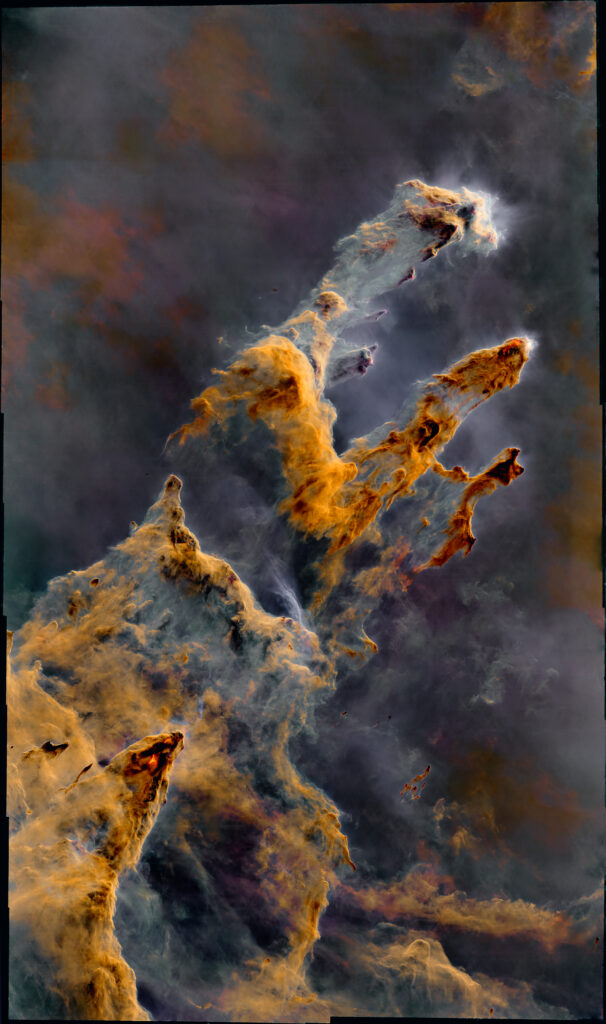
I finally reconstructed starry image in Photoshop by screen blending mode of stars layer group over starless one, with each group adjustement and pixel-fixing independetly made.
MIRI image followed a similiar processing work, with peculiar feature of very very intense pixel fixing intervent, both in stars and starless level.
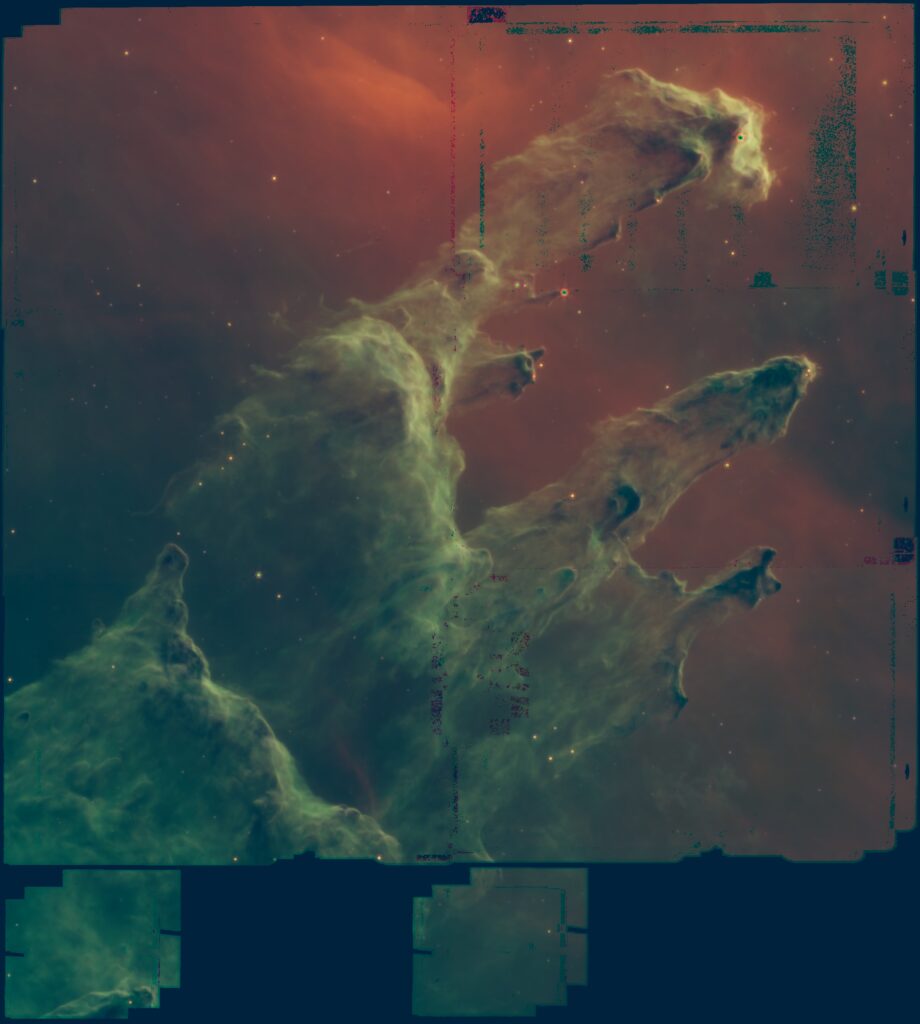
Starless image after pixel fixing and color calibration I find simply astonishing.
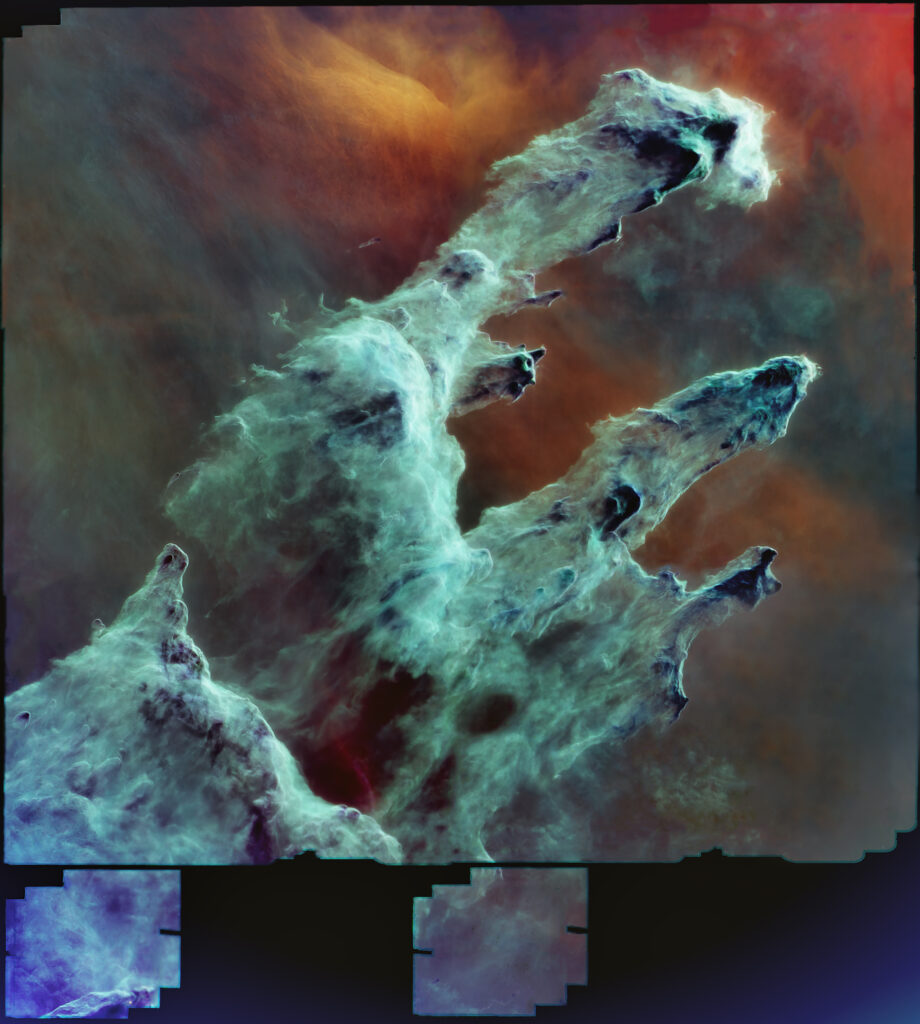
Starry final image reconstruction with few adjustements intervent
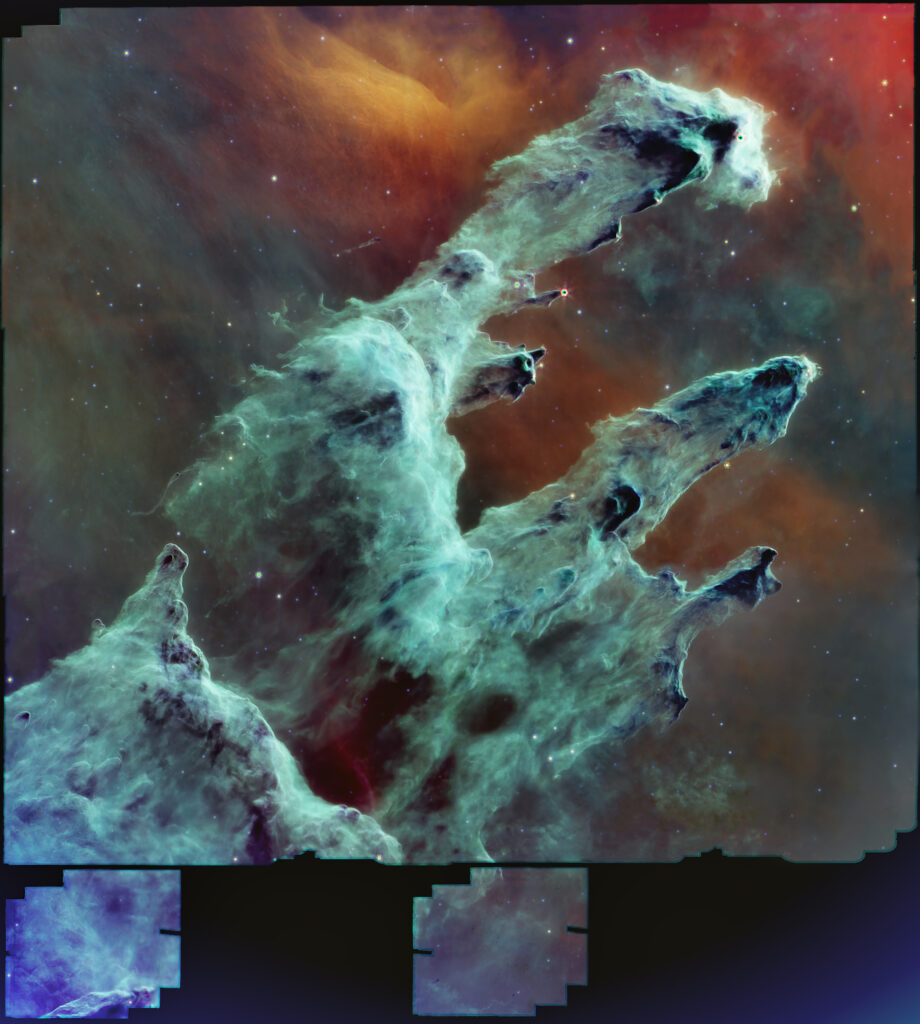
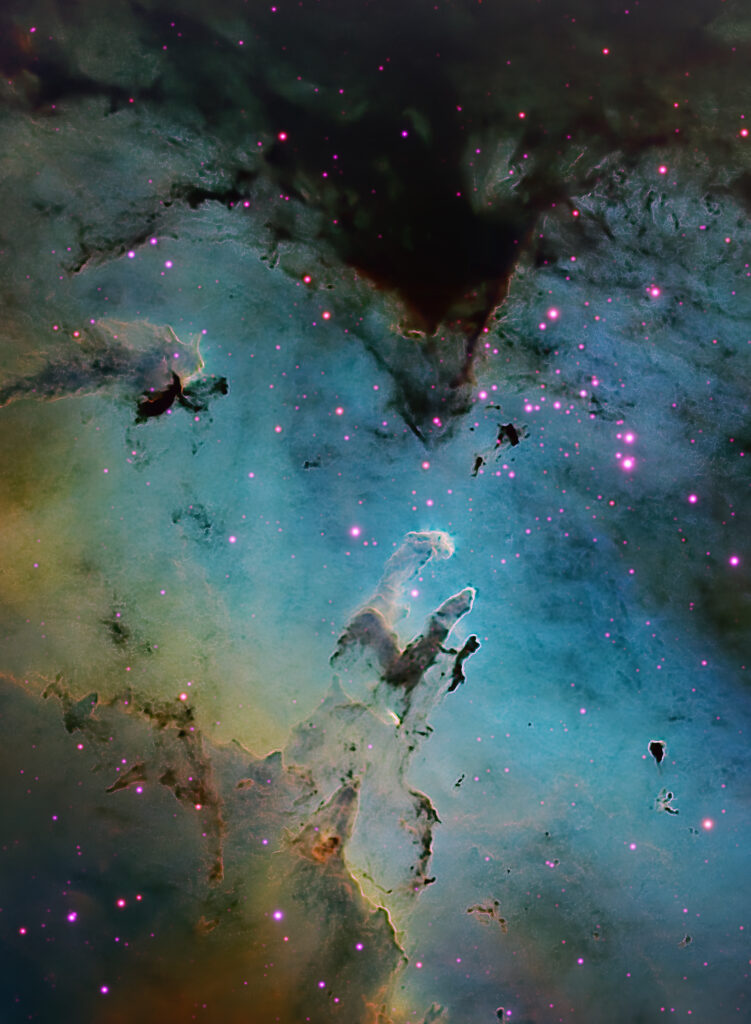
Astrobin:
M16 (NGC 6611) Eagle Nebula, or Star Queen Nebula, was discovered in 1745 by the Swiss astronome Jean-Philippe de Cheseaux while in 1745 and 1746, De Chéseaux compiled a list of 21 nebulous objects, of which he had originally discovered 8 objects: IC 4665, NGC 6633, M16, M25, M35 (this one might have seen before by John Bevis in England), M71, M4, and M17. Moreover, he independently re-discovered M6, NGC 6231 and M22 (No. 17).
De Chéseaux sent this list to his grandfather, Reaumur, in Paris, and it was read by Reaumur at a meeting of the French Academy of Sciences on August 6, 1746 and mentioned by Jean Maraldi in 1746 (Maraldi 1751), by Le Gentil in 1759 (Le Gentil 1765), but then stayed unpublished and more or less forgotten until Guillaume Bigourdan recovered and published it within a larger paper in 1884 (Bigourdan 1892).
For Cheseaux observation cfr.: http://www.messier.seds.org/xtra/similar/deches.html [18/07/2023]
M16 was independently rediscovered, and nebula IC 4703 discovered, by Charles Messier on June 3, 1764.
This nebula lies in the Sagittarius Arm of the Milky Way and became famous as the “Pillars of Creation” imaged by the Hubble Space Telescope.
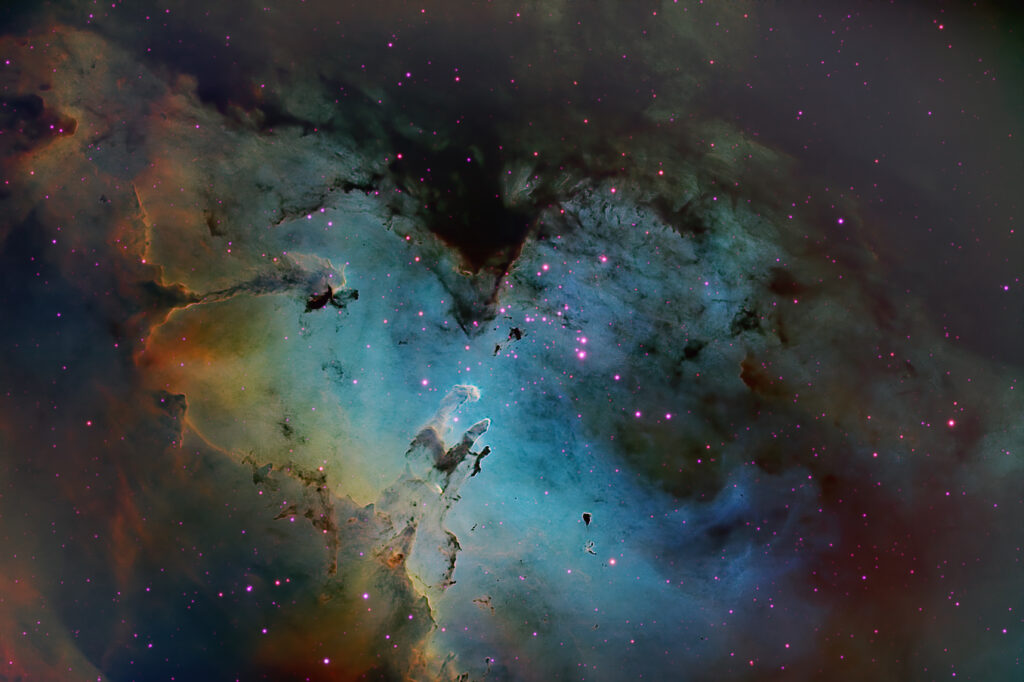
The nebula contains several active star-forming gas and dust regions, and is part of a diffuse emission nebula H II region, which is catalogued as IC 4703.
This region of active current star formation is about 5700 light-years distant.
According to NASA, ESA, and The Hubble Heritage Team (STScI/AURA) [ https://esahubble.org/images/heic0506b/ ] among peculiarities there’s the 90 trillion kilometers long spire of gas that can be seen coming off the nebula in the northeastern part appearing like a winged fairy-tale creature poised on a pedestal, this object is actually a billowing tower of cold gas and dust rising from a stellar nursery called the Eagle Nebula.
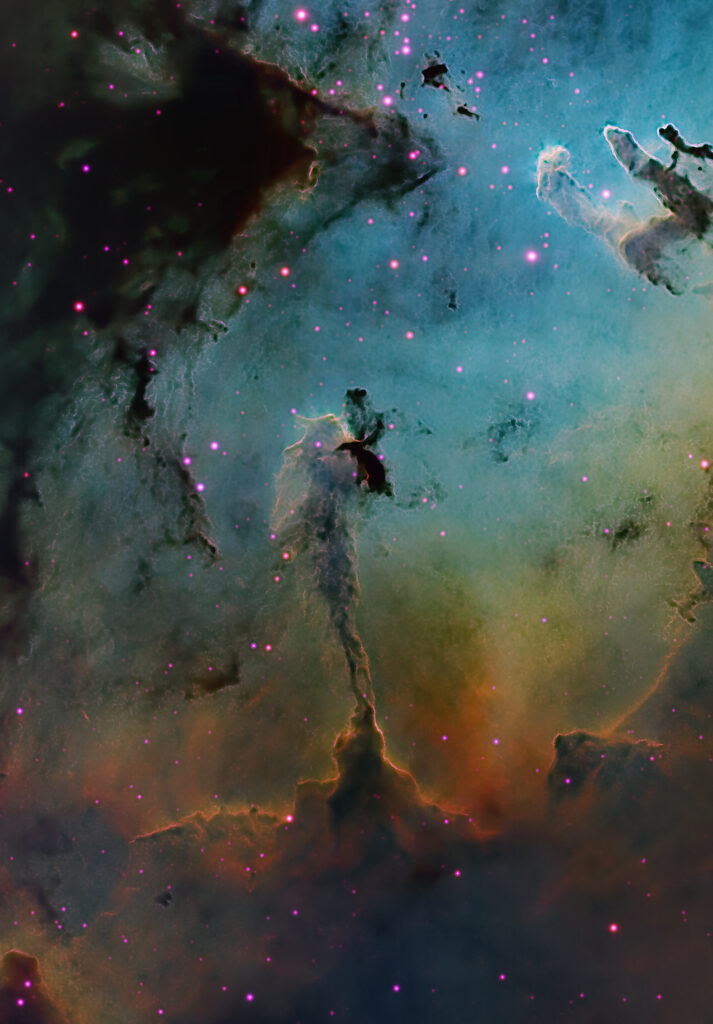
The name “Pillars of Creation” explains the gas and dust disposed in pillars clouds which are in the process of creating new stars, while also being eroded by the light from nearby stars that have recently formed, and it was given after the Hubble picture taken on April 1, 1995.
Astronomers responsible for the photo were Jeff Hester and Paul Scowen from Arizona State University.
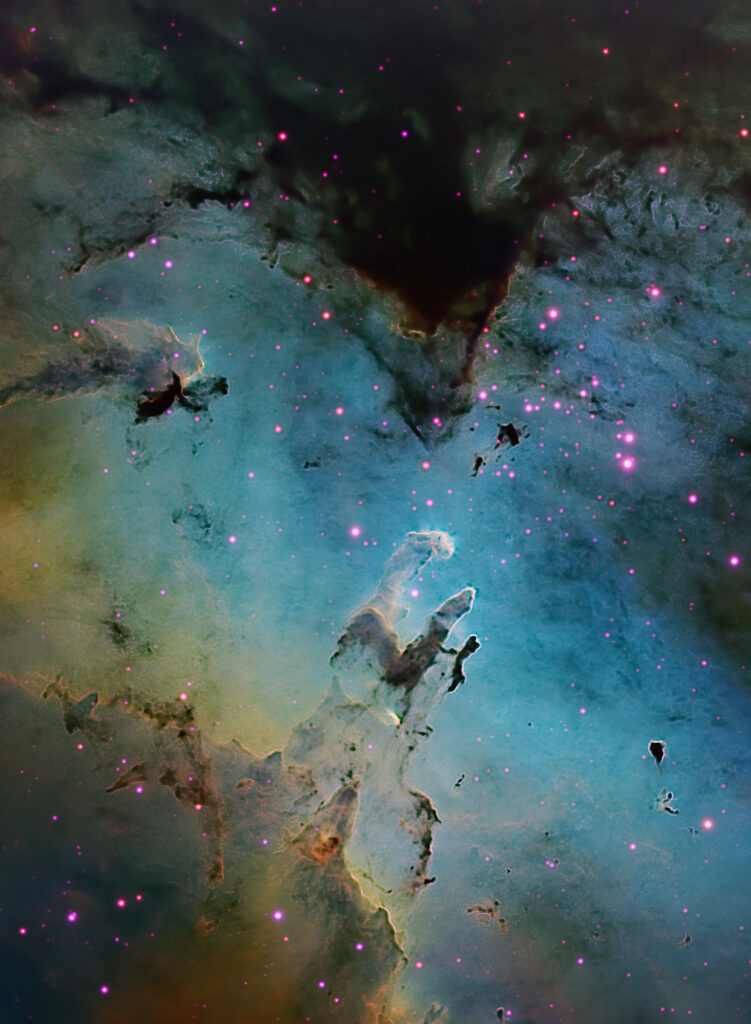
According to DeVorkin and Smith, 2015 [Devorkin, David H.; Smith, Robert W., 2015 “The Hubble Cosmos: 25 Years of New Vistas in Space.” National Geographic Society: 67 this name is based on a phrase used by Charles Spurgeon in his 1857 sermon “The Condescension of Christ”: by calling the Hubble’s spectacular image of the Eagle Nebula the Pillars of Creation, NASA scientists were tapping a rich symbolic tradition with centuries of meaning, bringing it into the modern age.
As much as we associate pillars with the classical temples of Greece and Rome, the concept of the pillars of creation – the very foundations that hold up the world and all that is in it – reverberates significantly in the Christian tradition. When William Jennings Bryan published The World’s Famous Orations in 1906, he included an 1857 sermon by London pastor Charles Haddon Spurgeon titled “The Condescension of Christ”. In it, Spurgeon uses the phrase to convey not only the physical world but also the force that keeps it all together, emanating from the divine: “And now wonder, ye angels,” Spurgeon says of the birth of Christ, “the Infinite has become an infant; he, upon whose shoulders the universe doth hang, hangs at his mother’s breast; He who created all things, and bears up the pillars of creation, hath now become so weak, that He must be carried by a woman!”
According to Bally et. Al., the pillars are composed of cool molecular hydrogen and dust that are being eroded by photoevaporation from the ultraviolet light of relatively close and hot stars. The leftmost pillar is about four light years in length. The finger-like protrusions at the top of the clouds are larger than the Solar System, and are made visible by the shadows of evaporating gaseous globules (EGGs), which shield the gas behind them from intense UV flux.[10] EGGs are themselves incubators of new stars.
The stars then emerge from the EGGs, which then are evaporated.
Cfr.: Bally, J.; Morse, J.; Reipurth, B. (1996). “The Birth of Stars: Herbig-Haro Jets, Accretion and Proto-Planetary Disks”. In Benvenuti, Piero; Macchetto, F.D.; Schreier, Ethan J. (eds.). Science with the Hubble Space Telescope – II. Proceedings of a workshop held in Paris, France, December 4–8, 1995. Space Telescope Science Institute. https://ui.adsabs.harvard.edu/abs/1996swhs.conf..491B/abstract [18/07/2023]
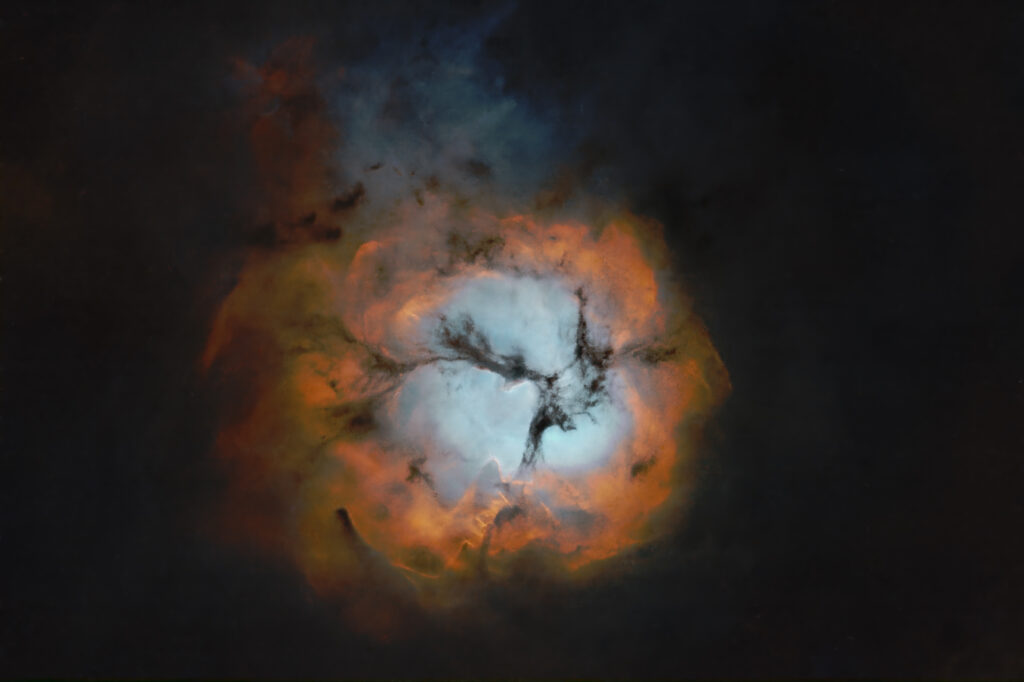
Astrobin: https://www.astrobin.com/8lkg32/
Date: 16 Giugno 2023
Astrodon H-alpha 3nm 50×50 mm: 6×300″(30′)
Astrodon OIII 3nm 50×50 mm: 4×300″(20′)
Astrodon SII 3nm 50×50 mm: 6×300″(30′)
Integrazione: 1h 20′, giorno lunare medio: 27.92 giorni, fase lunare media: 2.89%
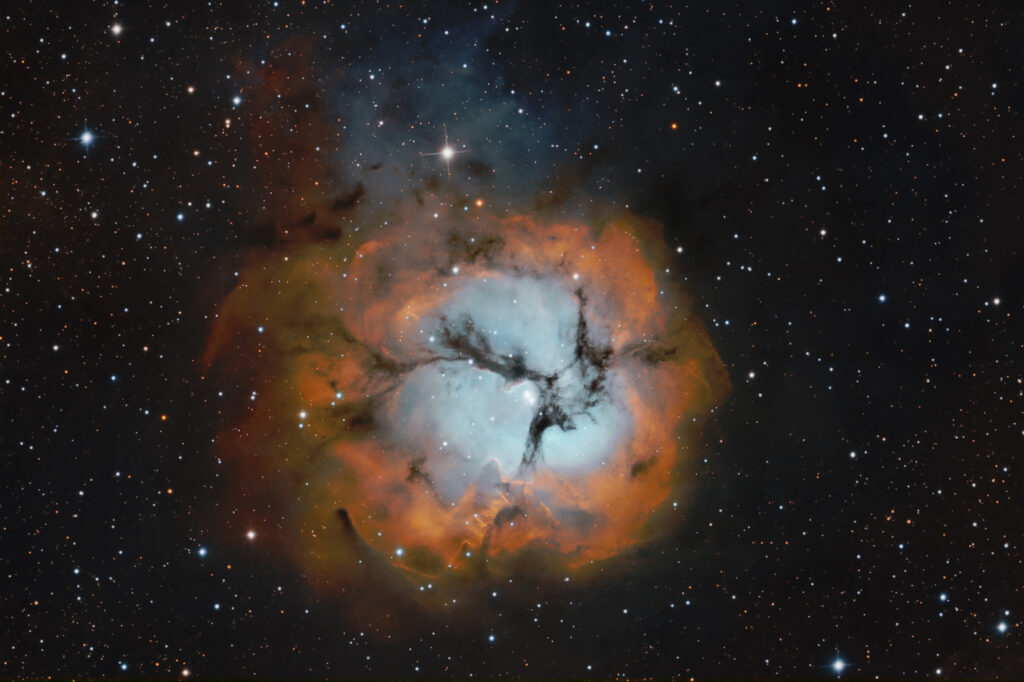
Telescopi O Obiettivi Di Acquisizione: Planewave CDK24
Camere Di Acquisizione: QHYCCD QHY600 Pro M ×
Montature: Mathis Instruments MI-1000/1250
Filtri: Astrodon H-alpha 3nm 50×50 mm · Astrodon OIII 3nm 50×50 mm · Astrodon SII 3nm 50×50 mm
Software: Adobe Photoshop · Pleiades Astrophoto PixInsight
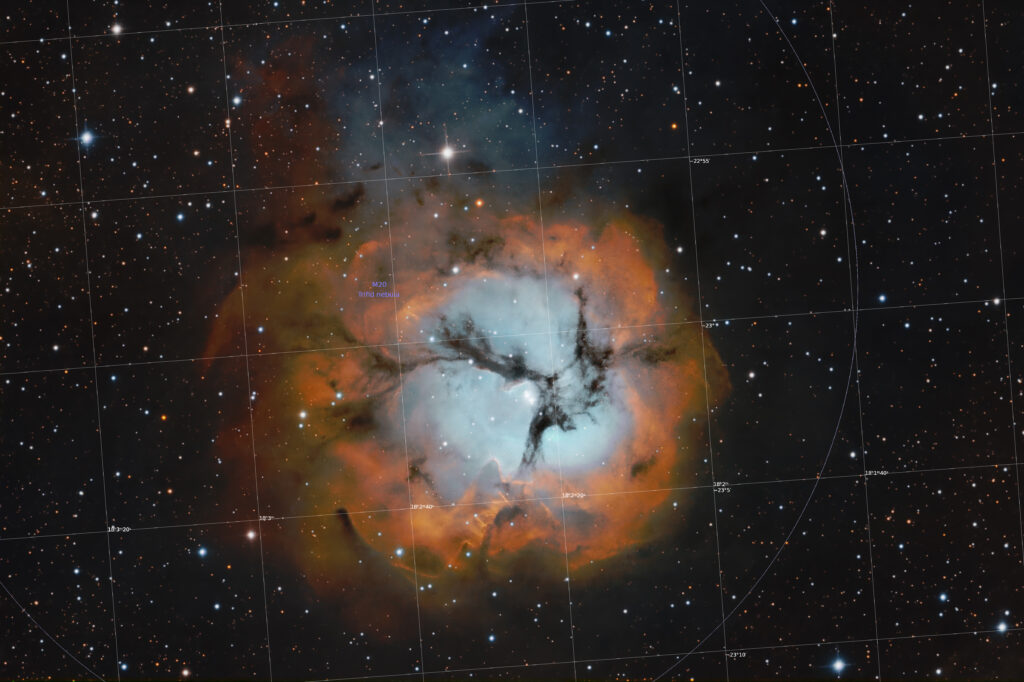
Annotations by PixInSight
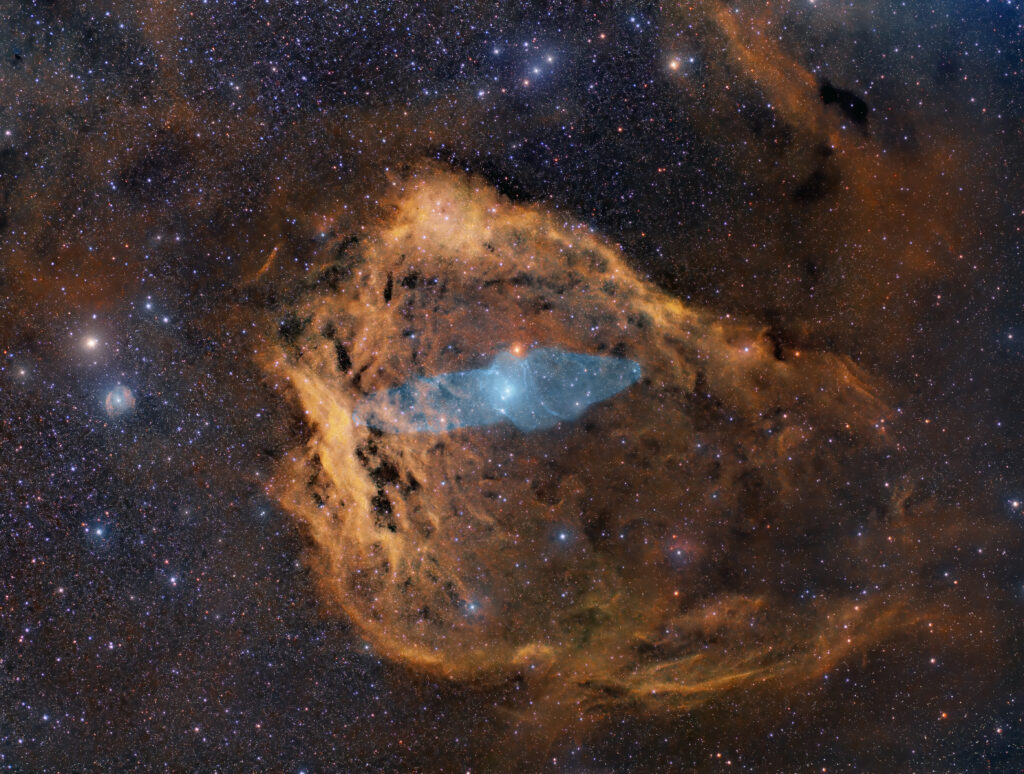
Sh2-129 emission nebula presents an irregular ring-arch form which resemble a figure of a flying bat, and according to Blitz et.Al. is situated at a distance of about 400 parsec or 1300 light-years.
According to Dobashi and collegues the region sourroundig Sh-129 is particularly rich of molecular clouds, first among all the whide obscure nebulositys system occulting the Milky Way in the direction of Cefeus; cfr. Dobahashi K. et Al., 1994 “Molecular Clouds in Cygnus. I. A Large-Scale 13CO Survey” – https://ui.adsabs.harvard.edu/abs/1994ApJS…95..419D/abstract
George Helou and collegues [ https://ui.adsabs.harvard.edu/abs/1988iras….7…..H/abstract ] studied the infrared radiation source IRAS 21168+5948 which coordinates coincide with the CO emission region, as just introduced within Avedisova Star Formation regions Catalogue; cfr. Avedisova V. S., 2002 “A Catalog of Star-Forming Regions in the Galaxy” in Astronomy Reports, vol.46 n.3: 193 – 205.
Within Sh2-129 center, recording in Oiii narrowband, is possible to enhance the vision of Ou4 nebula, whose form gave the name of squid nebula.
Discovered in 2011 by French astro-imager Nicolas Outters, the Squid Nebula’s alluring bipolar shape is distinguished by the telltale blue-green emission from doubly ionized oxygen atoms. Though apparently completely surrounded by hydrogen emission region Sh2-129, the true distance and nature of the Ou4 have been difficult to determine.
Recent investigation suggests Ou4 really does lie within Sh2-129 some 2,300 light-years away. Consistent with that scenario, Ou4 would represent a spectacular outflow driven by HR8119, a triple system of hot, massive stars seen near the center of the nebula.
The truly giant Squid Nebula would physically be nearly 50 light-years across.
This work is the result of personal SHO records using William Optics Redcat 51 and ASI1600mm Pro under Bortle 6 sky in Livorno – Italy (home balcony) with integration of records focused about Oiii signal obtained by Takahashi FSQ-106EDX4 and Proline FLI PL16083 camera retrieved from Telescopelive.
Data framelists set available:
here for WO51,
and here for Takahashi106
PixInSight cored workflow for generate 2 distinguished single channel SHO masters, linear-fit by Takahashi Oiii master, each pair blended by pixelmath within final S H and O masters, channel-combined in the SHO integration.
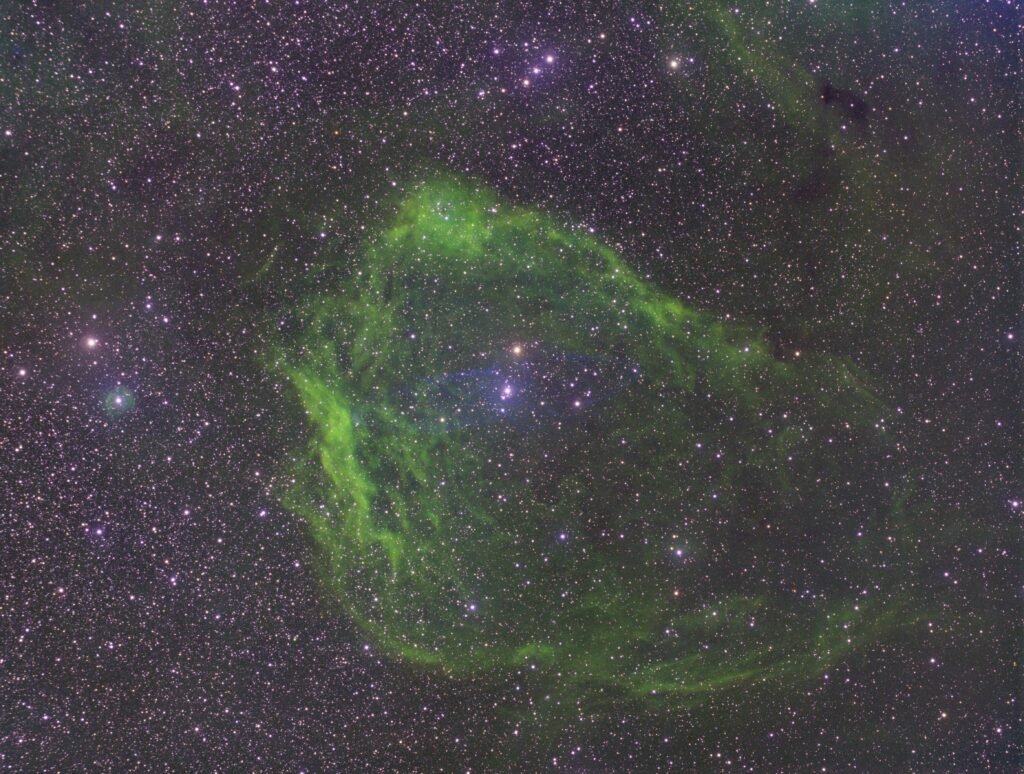
Normal narrowband workflow post-proccessing followed ‘till reaching an SHO starless
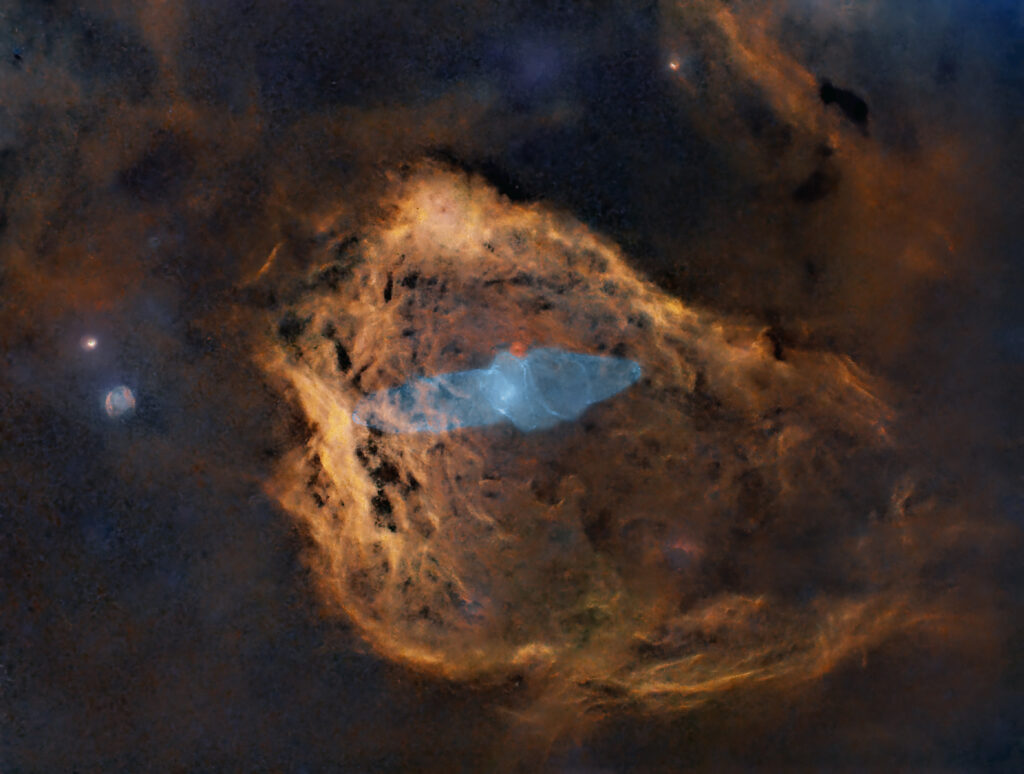
and SHO stars separated masters.
The same workflows I took for RGB channels, with the focus on star – separated from starless final integration to be used for final image composing.
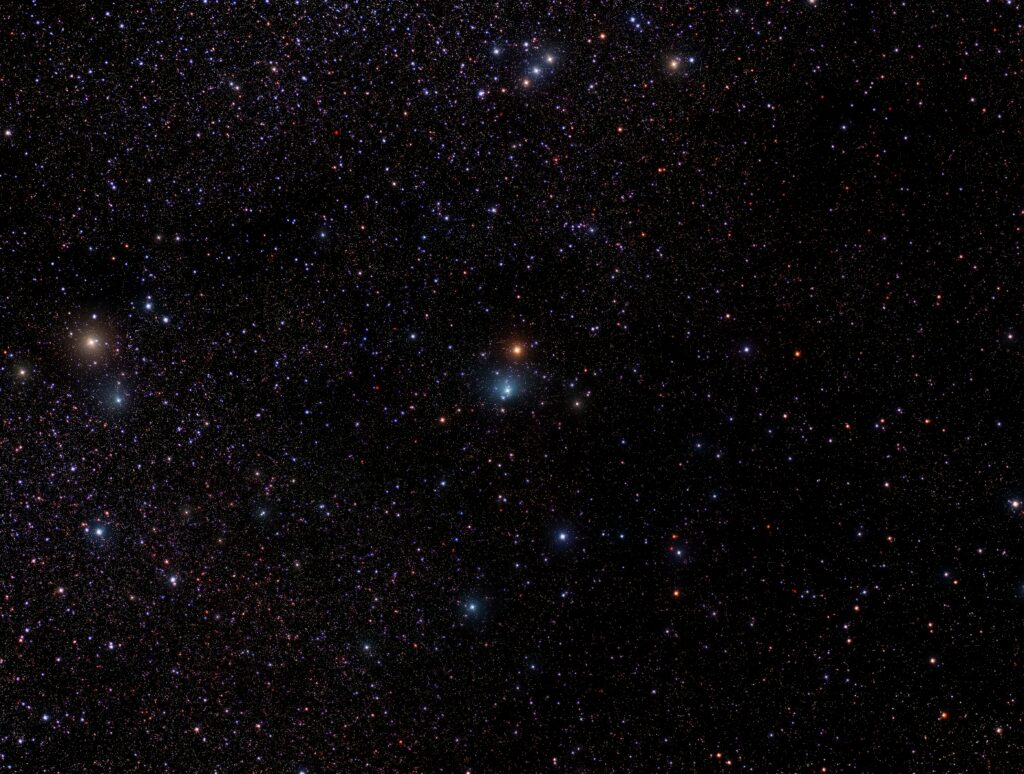
I then integrated in Photoshop by screen blending mode after necessary fixing and adjustements.
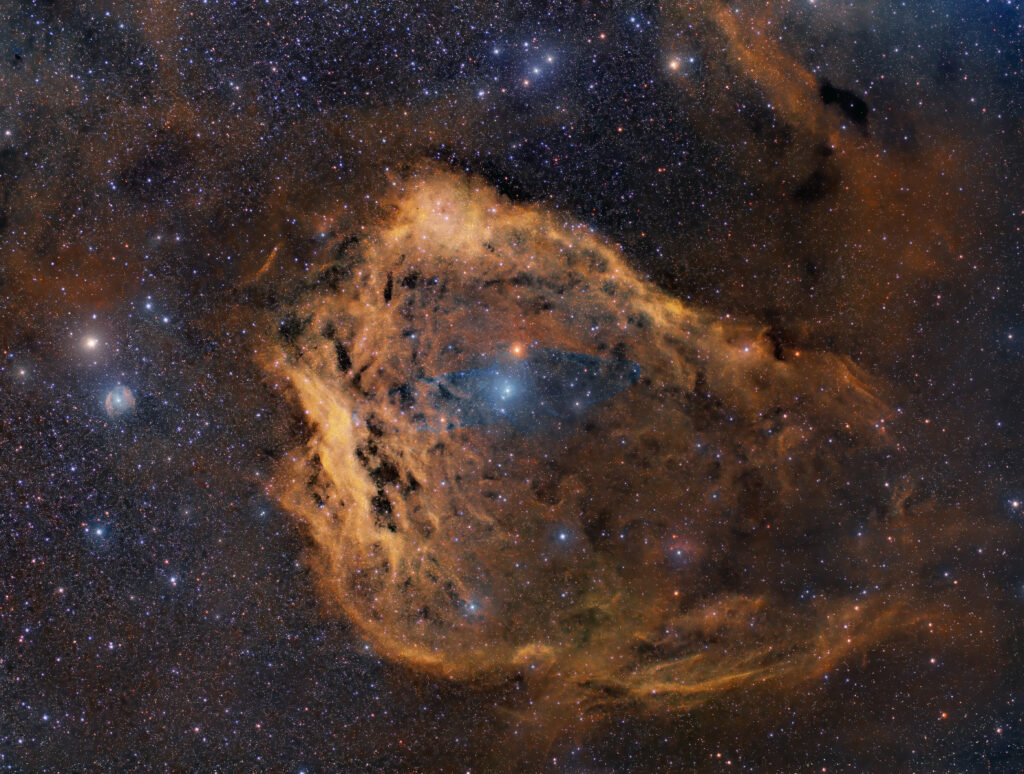
Parallely, the same workflow I made for Oiii master, using Oiii starless for enhancing Ou4 structure, luminosity and tones, in Photoshop by adjustements and colorizing filtered layer.
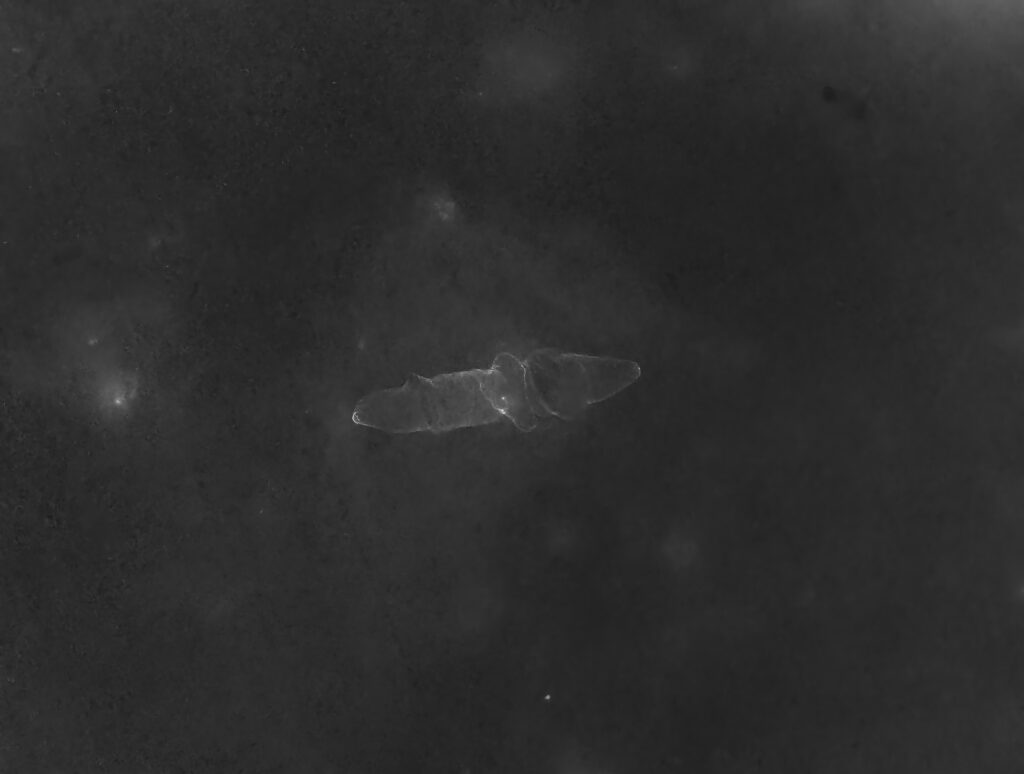
Integration of Oiii starless channel within SHO master enhanced luminosity, saturation and structure of Ou4 whole nebula.
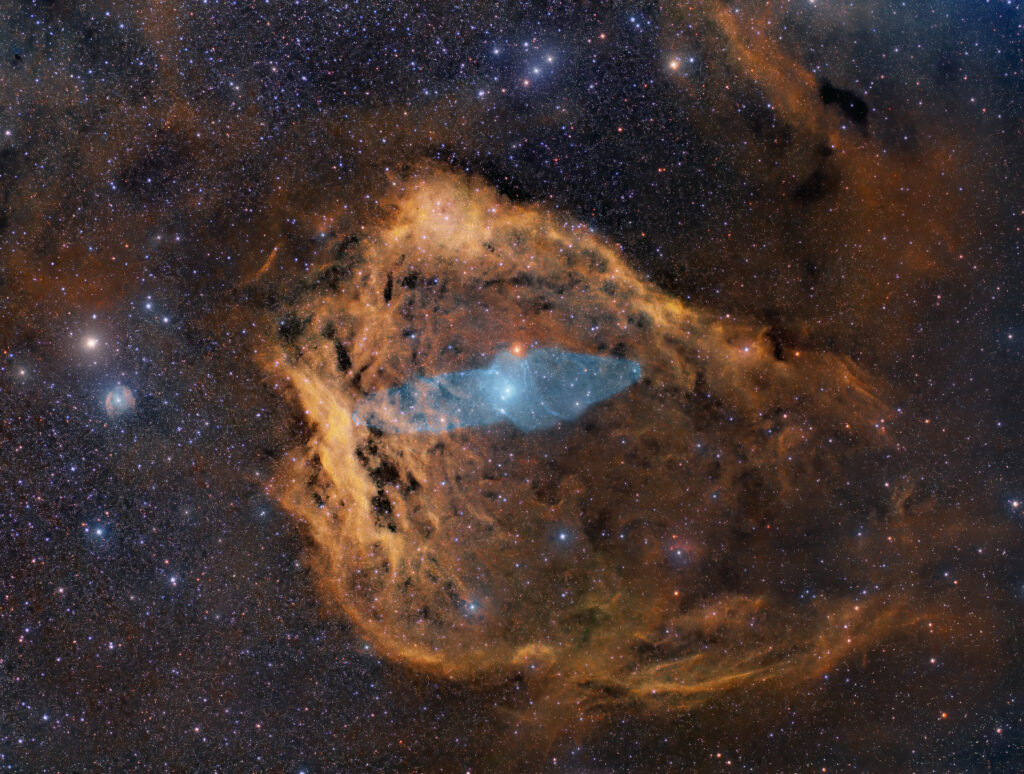
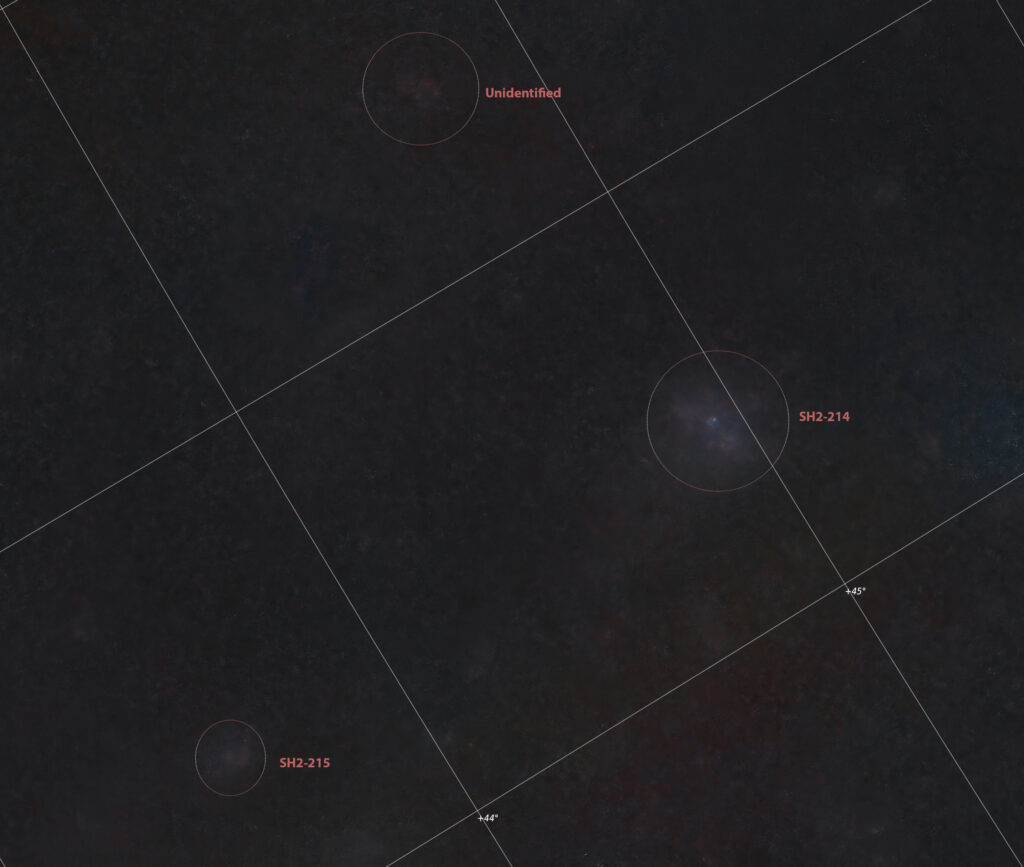
Sh2-214 and Sh2-215 very faint practically invisible Sh2 spot within Cepheus area; starless master shows both faint nebulosity and a third spot which I wasn’t able to identify.
There’s practically no literature about; cfr. https://simbad.u-strasbg.fr/simbad/sim-id?protocol=html&Ident=Sh+2-214&bibdisplay=none and http://simbad.u-strasbg.fr/simbad/sim-id?protocol=html&Ident=Sh+2-215&bibdisplay=none for Simbaud/Strasburg records.
Cfr. also http://galaxymap.org/cat/list/sharpless/1
Astrobin: https://www.astrobin.com/57nj2p/
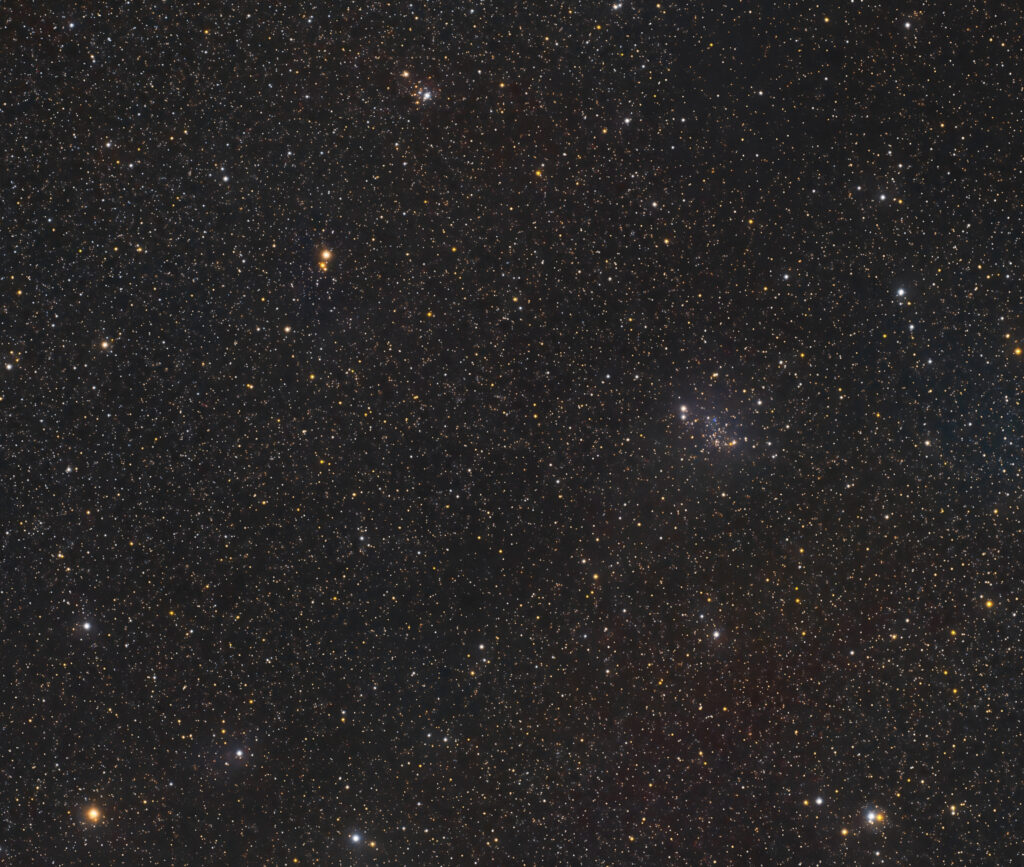
Starried (up) crop view and wider field from original integration.
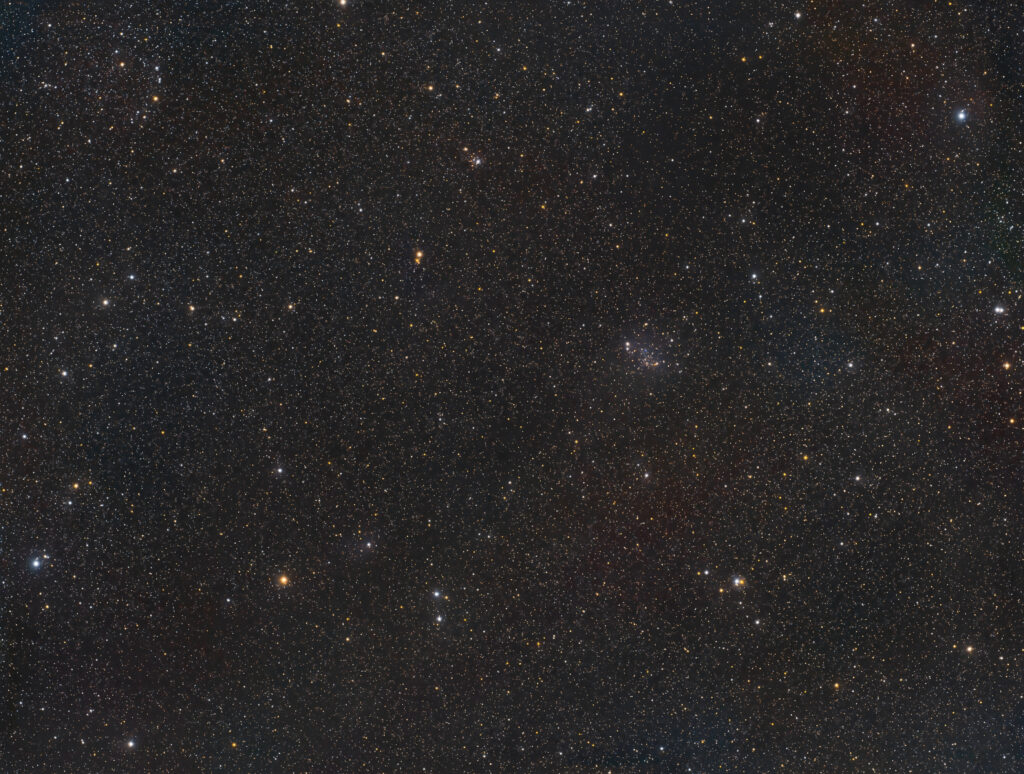
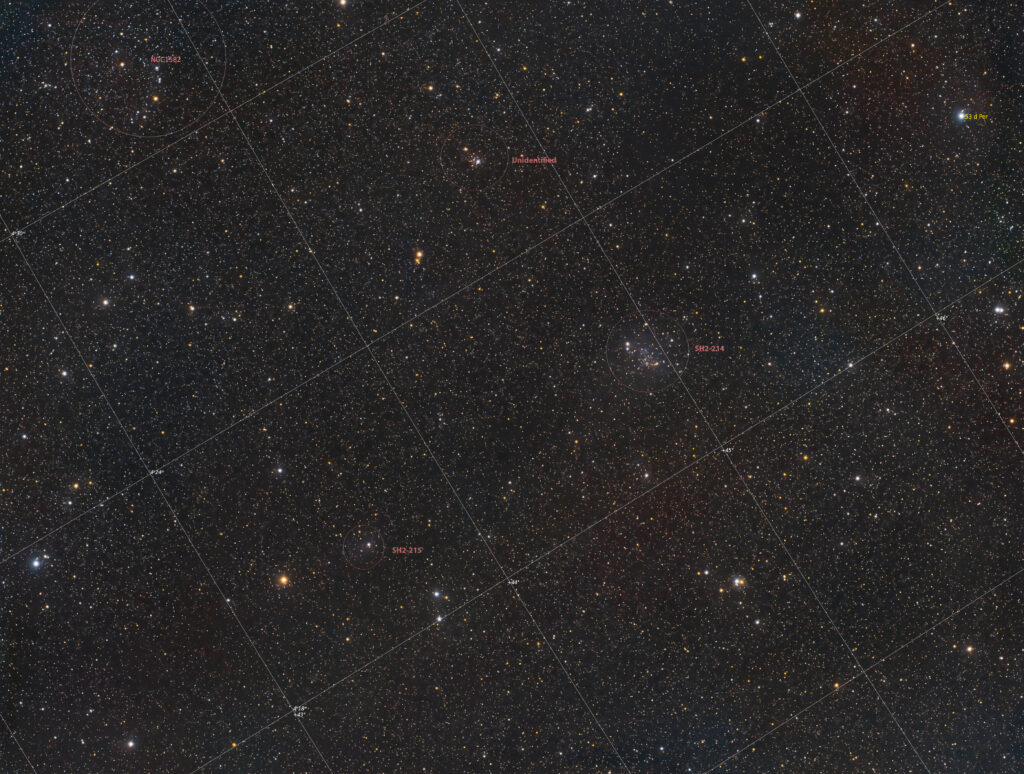
Sarried wider field with annotations.
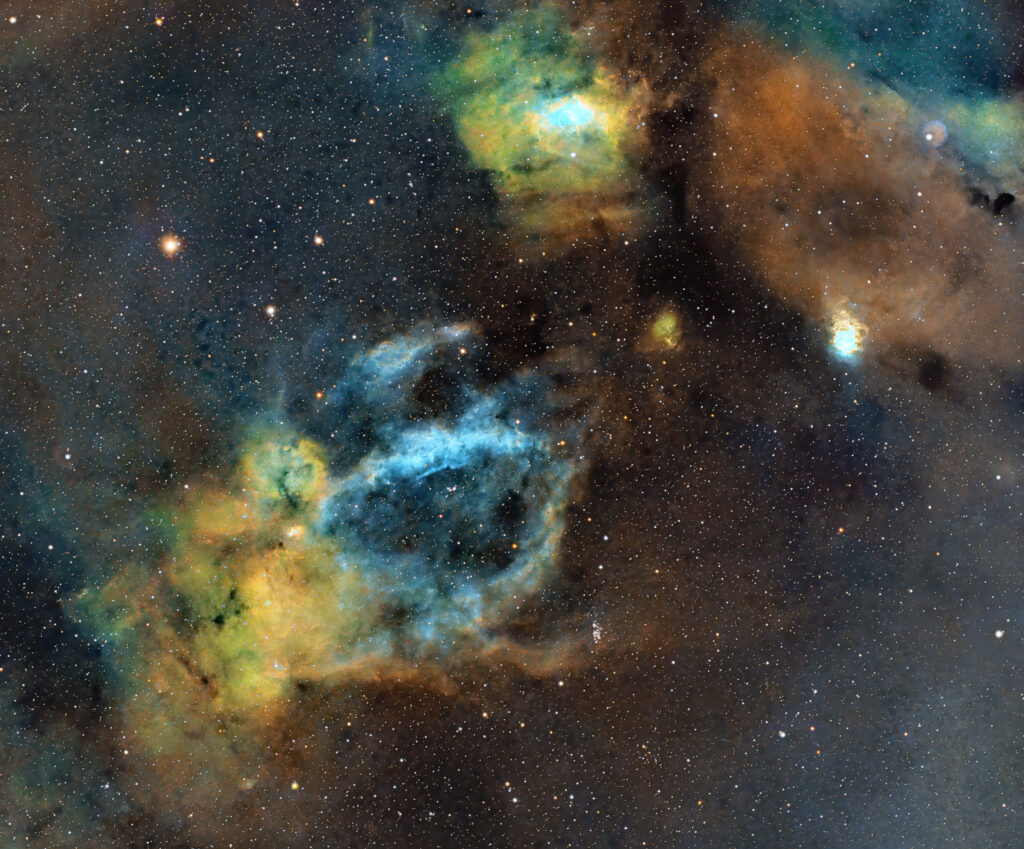
SH2-157, the Lobster Claw Nebula, is an emission nebula located about 11,000 light-years away in the constellation of Cassiopeia.
According to SHO palette, red/orange and predominantly yellow regions of the nebula evinced a very large H II region while the blue-colored are predominately regions featured by the emission of light from molecular oxygen.
On the top NGC 7635 – the Bubble Nebula, and on the middle the star cluster NGC 7510.
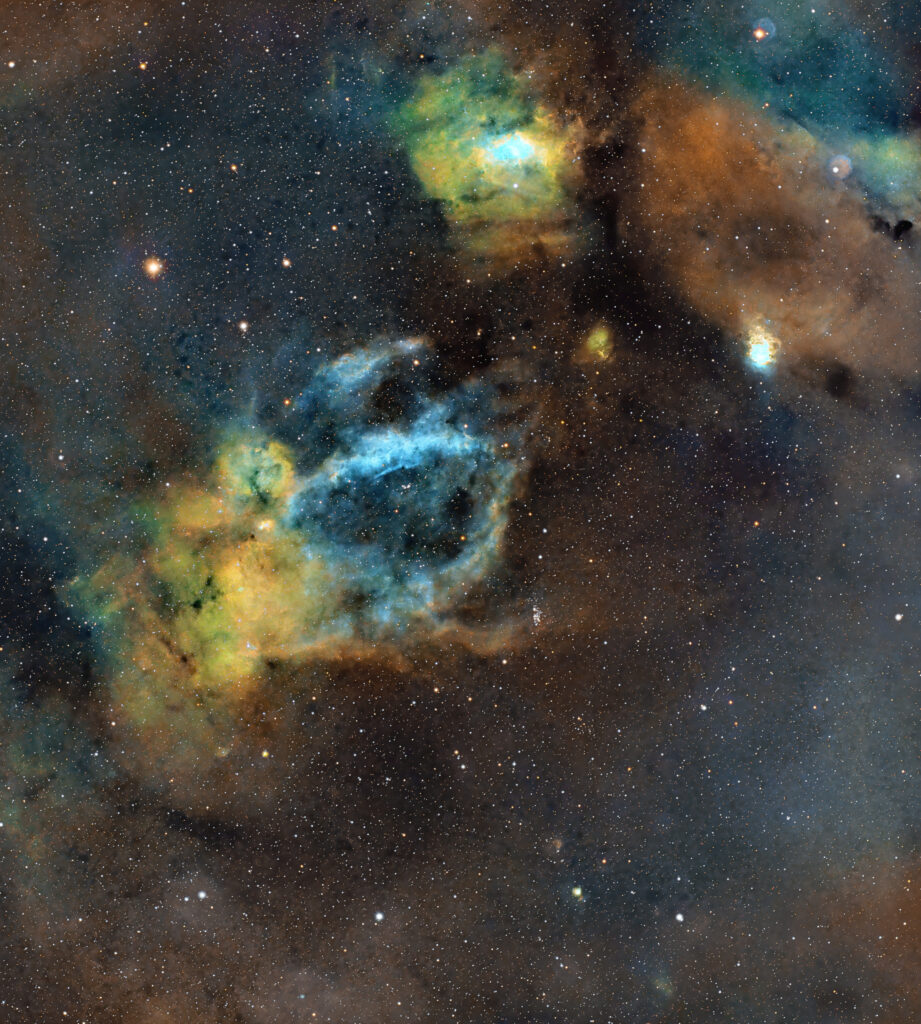
Astrobin:
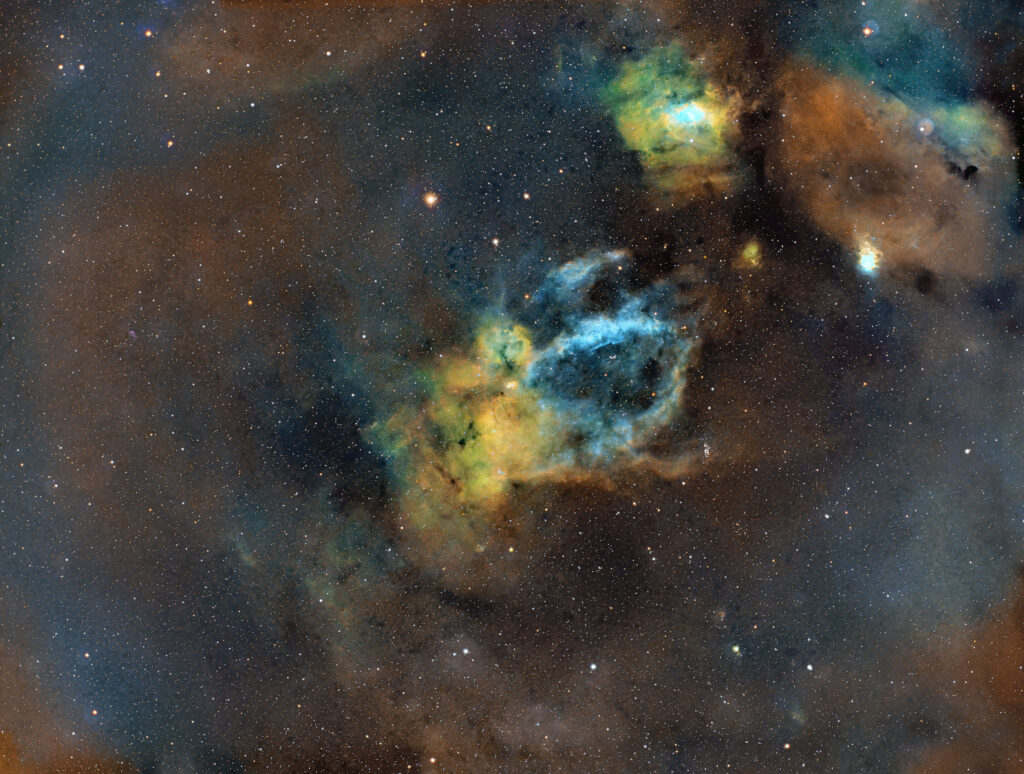
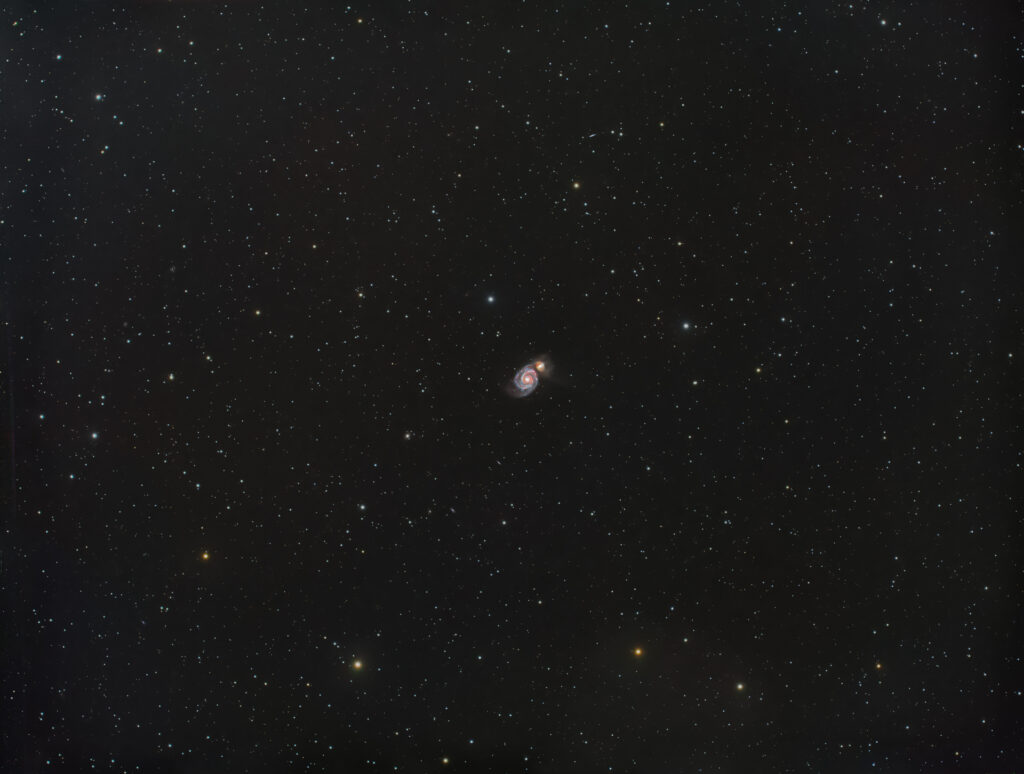
Astrobin :
Integration of HOO starless and RGB stars masters; luminance added by Ha channel.
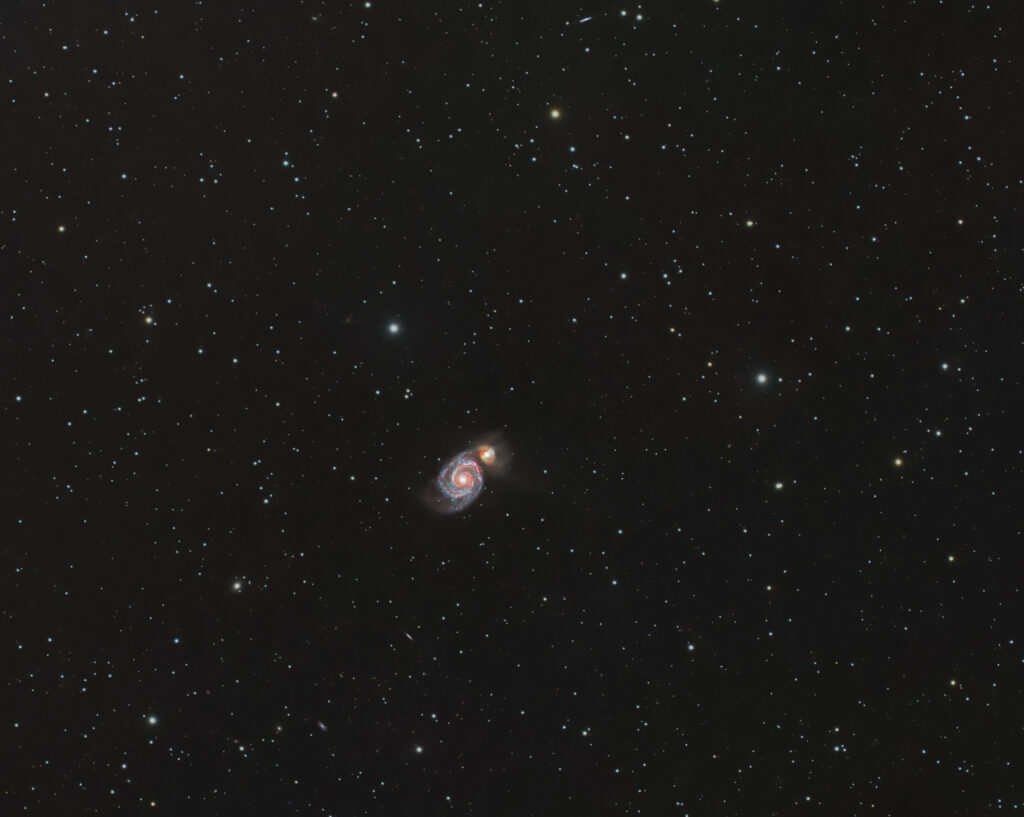
Narrowband Ha and Oiii subframes at 180″ -20C, gain 173 and gain 139. LRGB subframes at 60″.
Subframe list available here
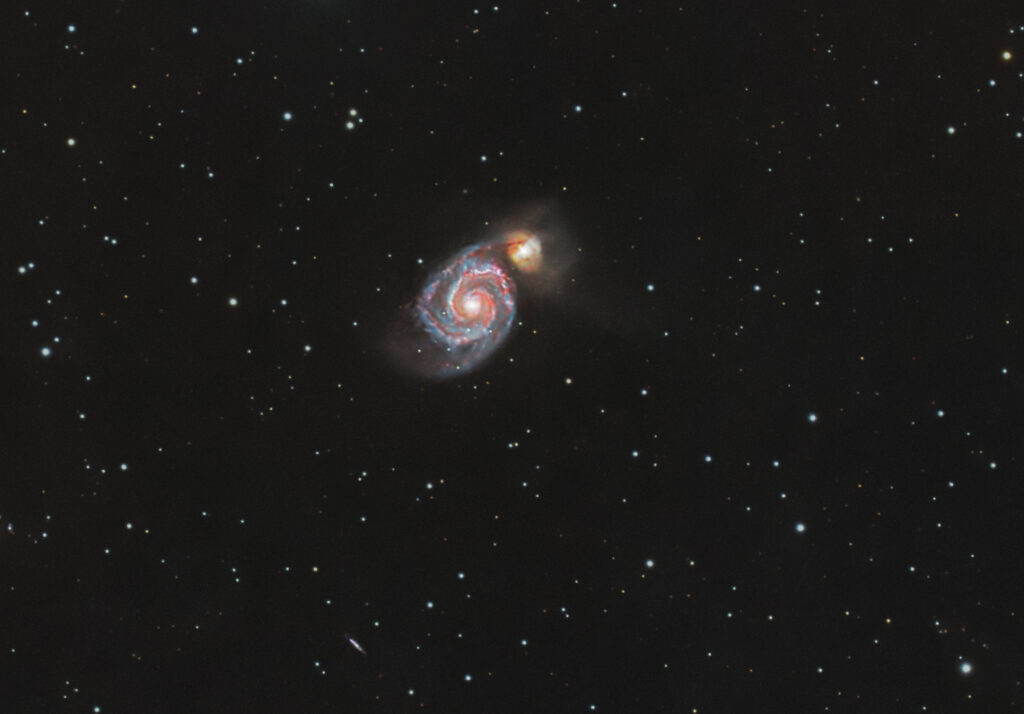
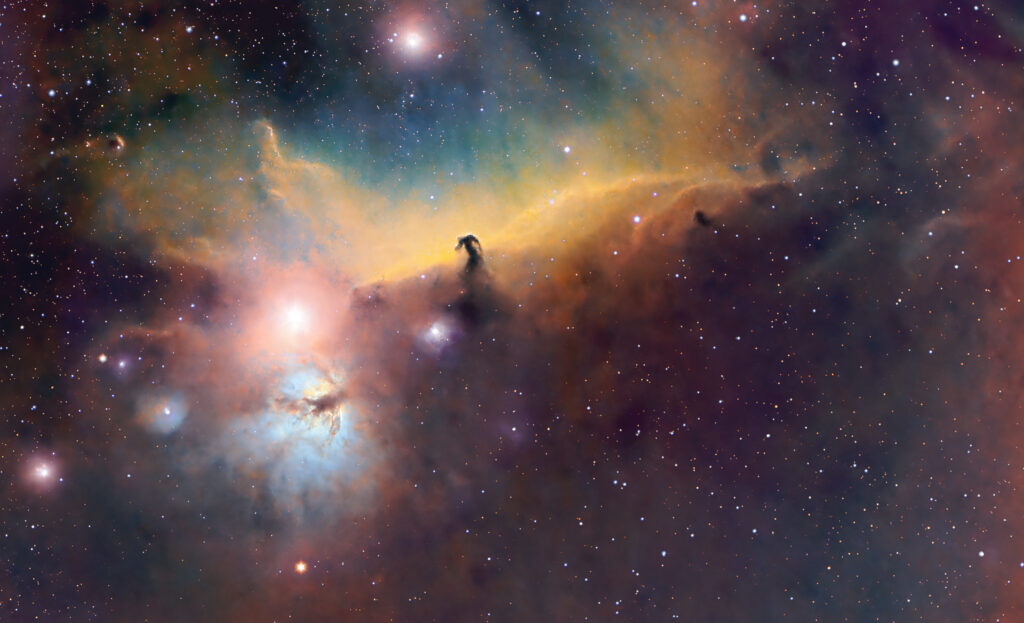
Astrobin: https://www.astrobin.com/mn32md/
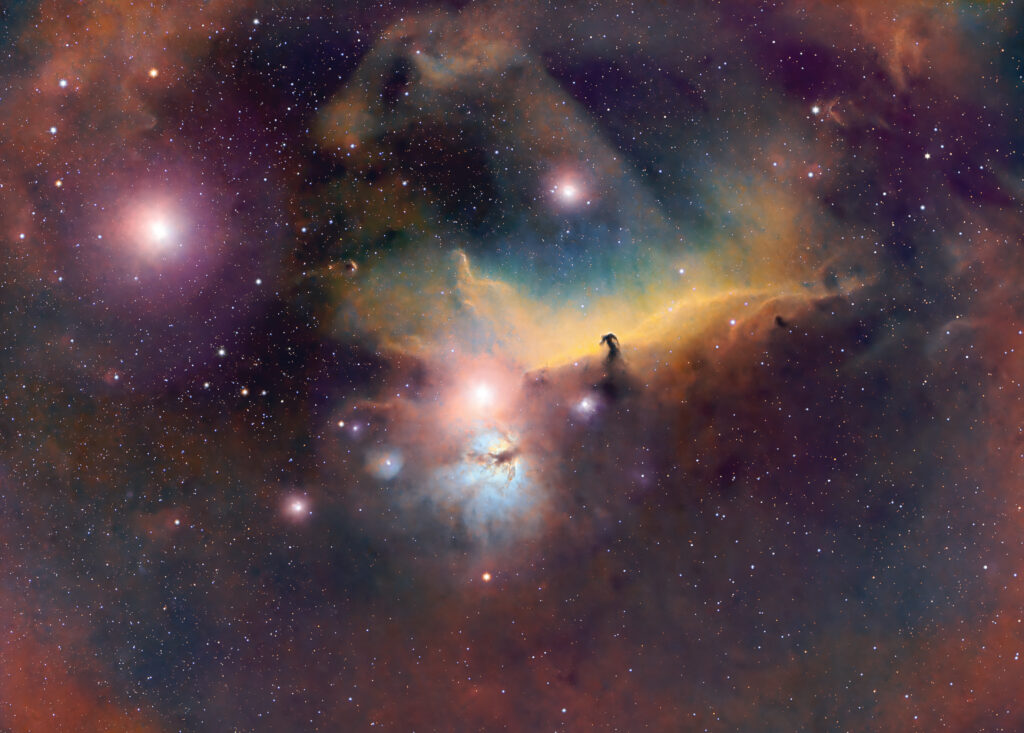
Telescopi O Obiettivi Di Acquisizione: William Optics Redcat 51
Camere Di Acquisizione: ZWO ASI1600MM Pro
Montature : Sky-Watcher EQM-35 ×
Filtri: Astronomik H-alpha CCD 6nm · Astronomik OIII CCD 12nm 1.25″ · Astronomik OIII CCD 6nm · Astronomik SII CCD 6nm
Accessori : ZWO ASIAIR Plus · ZWO ASIAIR Pro · ZWO EAF · ZWO EFW 8 x 1.25″ / 31mm
Software: Adobe Photoshop · Pleiades Astrophoto PixInsight
Telescopi O Obiettivi Di Guida : QHYCCD Mini Guide Scope
Camere Di Guida : ZWO ASI120MM Mini
Dettagli d’acquisizione
Date:
09 Dicembre 2021 · 11 Dicembre 2021 · 12 Dicembre 2021 · 13 Dicembre 2021 · 15 Dicembre 2021 · 16 Dicembre 2021 · 17 Dicembre 2021 · 18 Dicembre 2021 · 08 Gennaio 2022 · 09 Gennaio 2022 · 10 Gennaio 2022 · 11 Gennaio 2022 · 12 Gennaio 2022 · 13 Gennaio 2022 · 14 Gennaio 2022 · 16 Gennaio 2022 · 18 Gennaio 2022 · 22 Gennaio 2022 · 23 Gennaio 2022 · 24 Gennaio 2022 · 28 Gennaio 2022 · 29 Gennaio 2022 · 31 Gennaio 2022 · 01 Febbraio 2022 · 02 Febbraio 2022 · 05 Febbraio 2022
Pose:
Astronomik H-alpha CCD 12nm 1.25″: 79×180″(3h 57′) (gain: 139.00) -20°C bin 1×1
Astronomik OIII CCD 12nm 1.25″: 62×180″(3h 6′) (gain: 139.00) -20°C bin 1×1
Astronomik SII CCD 12nm 1.25″: 77×180″(3h 51′) (gain: 139.00) -20°C bin 1×1
Integrazione: 10h 54′
Dark: 33, Flat: 33, Dark dei flat: 33
Giorno lunare medio: 12.35 giorni
Fase lunare media: 58.64%
Scala del Cielo Scuro Bortle: 6.00
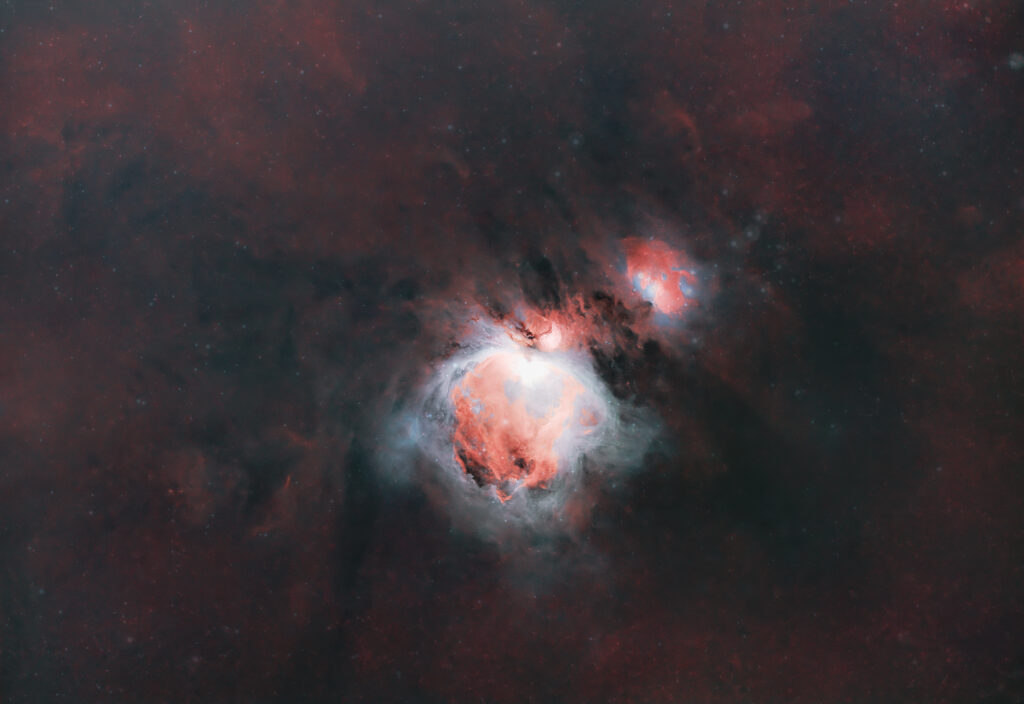
Astrobin:
Reprocessing 2022 records focused about M42 region.
In this work there’s a main core in LRGB, background removed, SPColorCalibrated, Deconvoltued and denoised is then integrated and boosted by Ha and Oiii narrowband master (Bgremoved, Deconvoluted and denoised) with Ha applied to L and R channel, Oiii to Green and Blue.
Final starless and 0.65 stars pixelmath blended and Photoshop retouches.
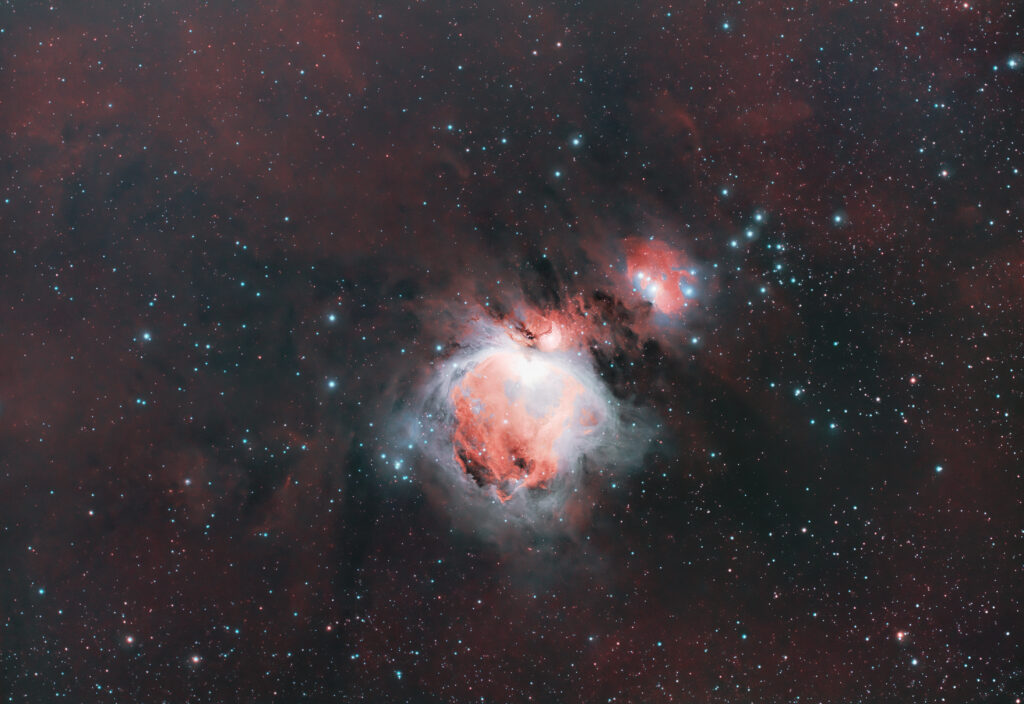
Social Widgets powered by AB-WebLog.com.